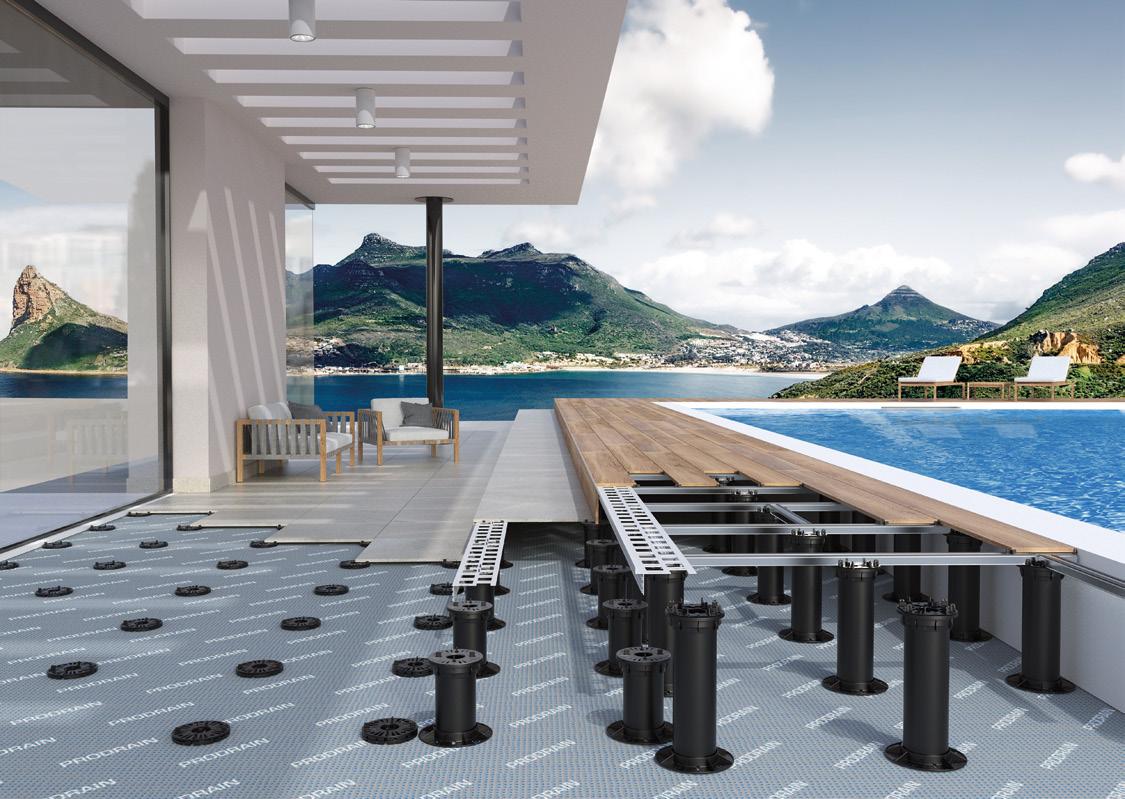economy news interviews trends

 Wall: B-MATERIA
Wall: B-MATERIA


 Wall: B-MATERIA
Wall: B-MATERIA
MyDesign by Schlüter-Systems





Profile und Ablagen exklusiv in Ihrer Farbe Profiles and storage shelves in your exclusive colour selection


MyDesign by Schlüter-Systems lässt jetzt individuelle Farbwünsche wahr werden! Ab sofort ist – zusätzlich zu unserer umfangreichen Farbpalette von TRENDLINE- und Pulverbeschichtungen – eine Vielzahl von Produkten auch in persönlichen Wunschfarben erhältlich. Zur Auswahl steht nun eine breite Palette von nicht weniger als 190 Farbtönen der RAL-Classic Farbpalette.

Implement your colour preferences now with MyDesign by Schlüter-Systems! Effective immediately, a wide range of products is available in individual colour choices, in addition to our extensive colour palette of TRENDLINE and powder coating options. Customers can now choose from an impressive 190 colours of the RAL classic colour chart.


Can you feel the sound of wellness?
Of course you can: the sound of water that pours down, descends, flows and leaves behind a sense of well-being and cleanliness.
A real symphony able to extend the pleasure of the shower, transforming a unique moment into sound. For that to happen, it is essential that the water flows without encountering obstacles: for this reason, we have designed the linear shower drains PP Drain Aqua, where beauty and functionality blend together. Isn’t this the sound of water?
PUBLISHER:
Tile Edizioni S.r.l. Capitale Sociale: Euro 51.400,00 R.E.A. 329775 Periodico bimestrale registrato presso il Tribunale di Modena al n. 22/17 in data 10/08/2017 Iscrizione al ROC n. 9673
OFFICE:
Tile Edizioni S.r.l. Via Fossa Buracchione 84 41126 Baggiovara (Modena) - Italy Tel. +39 059 512 103 - Fax +39 059 512 157 info@tiledizioni.it - www.surfacesinternational.com
EDITOR AND PUBLISHING COORDINATION: GIAN PAOLO CRASTA - g.crasta@tiledizioni.it
© 1989 Tile Italia
CO-EDITOR:
Sabrina Tassini
CONTRIBUTING EDITORS:
Sara Falsetti
Paola Giacomini
Sabino Menduni
Chiara Poggi
Sabrina Tassini
SECRETARIAT: info@tiledizioni.it
GRAPHIC LAYOUT:


Sara Falsetti
EACH COPY: Euro 4
SUBSCRIPTION:
www.tiledizioni.it/subscription
• Italy, 1 year: Euro 50
• Abroad, 1 year: Euro 70
• Italy, 2 years: Euro 70
• Abroad, 2 years: Euro 90
L’abbonamento decorre dal mese di distribuzione. Tariffe speciali per gli abbonamenti collettivi sono disponibili su richiesta Conto Corrente Postale 20026415 intestato a Tile Edi-
zioni srl. Spedizione in abbonamento postale presso la Filiale di Modena. L’IVA sugli abbonamenti, nonché sulla vendita dei fascicoli separati, è assolta dall’Editore ai sensi dell’art 74 primo comma lettera C del DPR 26.10.72 N. 633 e successive modificazioni.
ADVERTISING:
Tile Edizioni Tel. +39 059 512 103 Fax +39 059 512 157


• Paola Giacomini p.giacomini@tiledizioni.it +39 335 186 4257
• Silvia Lepore s.lepore@tiledizioni.it · +39 345 721 8245 Alberto Tolomelli a.tolomelli@tiledizioni.it +39 335 594 8681
• Elisa Verzelloni e.verzelloni@tiledizioni.it · +39 338 536 1966
PHOTOLIPHIE:
Vaccari Zincografica Srl Via E. Salgari, 61 - 41126 Modena - Italy
PRINT:
Faenza Printing Industries SpA Via Vittime Civili di Guerra, 35 48018 Faenza (RA) - Italy
http://www.
Tutti i diritti di riproduzione e traduzione degli articoli pubblicati sono riservati. E’ vietata la riproduzione anche parziale senza l’autorizzazione dell’Editore. Manoscritti, disegni, fotografie e altro materiale inviato in redazione, anche se non pubblicato, non verrà restituito. L’Editore non accetta alcuna pubblicità in sede redazionale. I nomi, le aziende e i prezzi eventualmente pubblicati sono citati senza responsabilità a puro titolo informativo per rendere un servizio ai lettori. La Direzione non assume responsabilità per opinioni espresse dagli autori dei testi redazionali e pubblicitari.
Entire contents Copyright Tile Edizioni srl
All right reserved.
Opinions expressed by writers are not necessarily those held by the publisher who is not held responsible.

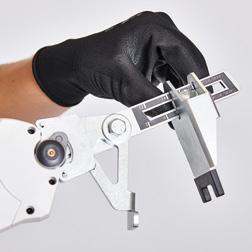

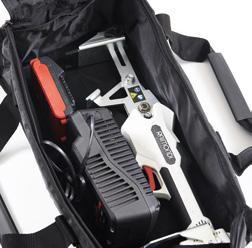




2022 will certainly not go down in the annals as a period of radiant serenity and prosperity. The clouds that gathered in February with the outbreak of war in Ukraine, just when we all thought we had finally shaken off the fall-out from the Covid-19 pandemic, only darkened as the energy crisis escalated, triggering a domino-effect of inflation, price rises, difficulties in sourcing raw materials and increases in borrowing costs and mortgage rates…factors with which we are now all too familiar.
Despite this complex backdrop, full of contrasts, the world ceramic industry seems to be enjoying good health, in the wake of growth in 2021, as revealed by a study conducted by the MECS research centre, which we publish in this issue: world tile production rose to 18,339 million square metres, up 7.2% on the 17,101 million recorded in 2020, on the back of a sharp upturn in demand in all parts of the world,
g.crasta@tiledizioni.itwhich saw world tile consumption rise to 18,209 million square metres (up 6.8%).
To provide a clearer insight into what is going on in the market, we also publish three interviews with top industry players, followed by details of numerous new products unveiled at the most recent trade shows, as well as a series of architectural projects that use innovative and sustainable ceramic solutions and installation systems, while looking to the future with enthusiasm and a commitment to continuous improvement.
As usual, we also publish an overview of the most interesting non-ceramic coverings, in the sections prepared in partnership with the online portal surfacesinternational.com, which you can visit by scanning the QR code shown at the beginning of the section. ✕
Following the ecological transition towards a sustainable world, Mapei and Panariagroup joined forces to present the first ceramic flooring system certified 100% Carbon Neutral including laying materials and tiles.

It consists of Panariagroup ultra-thin ceramic tiles, to be laid with Mapei solutions, Keraflex Maxi S1 zerø adhesive and Ultracolor Plus. The entire production of CO2 emitted during the life cycle of the products is 100% offset with the purchase of certified environmental credits to encourage the implementation of renewable energy projects.
This result stemmed from a common awareness: around the world, buildings, homes and the general construction industry are responsible for 36% of the entire global energy consumption as well as 37% of all energy-related CO2 emissions.
This partnership finally offers a highly innovative system, opening up to increasingly sustainable construction, hence to new solutions for Real Estate. “In our products, we have always paid close attention to the environment and sustainability”, Marco Squinzi, Mapei’s CEO, stated.
In 2012, the giant of chemical products for construction industry decided to invest in a team of R&D, starting to devel-
op eco-design projects with environmental criteria as well. In this direction, Mapei understood that durability was as important as composition.
“We therefore created Keraflex maxi S1 zero, the first glue for thin slabs laying, optimized for durability too”, Squinzi continued. “The production of Co2 emitted during the life cycle of the products is 100% compensated with the purchase of certified environmental credits to encourage the implementation of renewable energy projects. Making 100 square meters of flooring with this system is therefore equivalent to supporting the absorption of 20 trees. This was a very important year for us - Squinzi concludes - as in 2021 we carried out a sustainability report on all the European branches. In the coming year we want to extend it to all worldwide branches. We are strongly aware to intervene in all areas of action, ranging from the self-production of electricity to paper saving and solar panels”.
Sustainability is at the centre for Panariagroup too, providing solutions that are environment-friendly.
“Today is the right time to convey this message - Emilio Mussini, the president of the Gruoup, explains - because the awarness on this issue is growing globally. Our journey began in 2004 with super thin 3.5 mm slabs and it has never stopped. Mapei is always one step ahead when it comes to sustainability, hence we have been confident it is the perfect partner to continue on this path. We want to prove that, even in a construction system, it is possible to supply a 100% Carbon Neutral certified product”.
THINK ZERO is an ambitious project that is part of a Sustainability Plan adopted by Panariagroup, which has goals up to 2030. Investing in the planet and in a more responsible business model is a necessary step to go in the direction of the Paris Agreement and avoid the worst consequences of climate crisis.
Cersaie 2022 received over 90,000 visitors, including more than 44,000 international operators
The 39th edition of Cersaie, the International Exhibition of Architectural Ceramic and Bathroom Furnishings, met the highest expectations: the 15 halls of the Bologna Trade Fair Complex, covering a total area of 140,000 square metres, were booked to capacity by 624 companies, including 354 ceramic tile manufacturers, 88 bathroom furnishing companies and 183 businesses representing installation products, raw materials, new types of covering and service activities.
The show had a marked international character, confirmed by the presence of 237 foreign exhibitors - 38% of the total - representing 26 countries.
Over the five days of the show, Cersaie 2022 received 91,296 visitors, representing a rise of about 50% compared to last year’s edition, which marked one of the first returns of a major trade fair in the difficult post-pandemic period. 2022 attendance was therefore not far off that of 2019, which saw an influx of 112,340 visitors. There were 44,215 foreign visitors to this edition, equating to 48.4% of the total, and 47,081 Italian visitors.
The event was also attended by 458 journalists, 226 of whom were from outside Italy.

“I’m in no doubt that the investments made by the 624 exhibitors at Cersaie 2022 have achieved the best possible return, from a trade show that has confirmed its national and international importance among distributors, architects, installers and real estate developers,” says Giovanni Savorani, President of Confindustria Ceramica. “Ceramic is still gaining increasing shares of international markets due to its intrinsic characteristics, such as health, hygiene and durability. The Italian ceramic industry’s commitment to sustainability was the common thread of the whole event and was also reflected in the meeting, held at the trade show, with regional and local institutions to monitor the progress and results of the voluntary agreement on minimising the ceramic cluster’s emissions. The energy transition that we have embarked upon must not be undermined by the dramatic consequences of the crisis on the energy markets, which requires urgent action at European and national level, as we have made clear to the various political and institutional representatives who visited us at the trade fair.”

Emilio Mussini, Vice-President of Confindustria Ceramica and Head of Promotional Activities and Trade Fairs, summed up the extensive programme of events held at this edition of Cersaie as follows. “Over 2,000 people took part in the four meetings under the ‘Building, Dwelling, Thinking’ programme, 23 ‘press cafés’ were live-streamed and held face-to-face over the five days of the trade fair, and there was a continuous stream of visitors to Tiling Town. Over 200 operators from Europe, North America and the Gulf made up the Cersaie Business delegation, which was made possible by the invaluable collaboration of the Italian Foreign Ministry and the Italian Foreign Trade Institute.” The next edition of Cersaie will be held in Bologna from 25 to 29 September 2023.
Florim has opened a showroom in Rome, very near the famous Spanish Steps and Palazzo Chigi.
The ground floor has large display windows through which natural daylight floods the interior. It contains spaces entirely furnished with the Florim surfaces for various intended uses, alongside a more technical area dedicated to the Magnum Oversize large slabs (up to 320x160cm).
The basement floor houses an area focused on outdoor applications, a work area reserved for the use of architects and interior designers, and an office zone
GROHE announces the GROHE X Summit 2023 “Caring for Water”
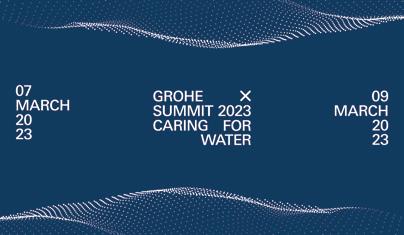
The store, of about 350 m2, is located within the historic Palazzo di Propaganda Fide, one of the capital’s finest examples of Baroque architecture. The entrance and three display windows are on Via dei Due Macelli 50 at the junction with Via di Capo le Case, on which the showroom continues with another four windows. It is a setting of the highest historic prestige for the promotion of Florim products and the use of large slabs as a design feature. An undisputed global hub for fashion and luxury, Italy’s capital is an essential destination for professionals in the world of design, furnishings and architecture. The opening is a further step forward in the project to promote the company’s image and establish ties with top engineering and architecture firms which began thirteen years ago and has led to a sequence of nine inaugurations of flagship stores in the most important design centres in Italy and worldwide.
The display spaces maintain the same stylistic identity as the other showrooms: the Florim Gallery in Fiorano Modenese (Modena) and the Flagship Stores in Milan, New York, Moscow, Singapore, Frankfurt, London, Abu Dhabi and Paris.
The Rome flagship store has a multifunctional concept and a two-floor layout.
GROHE, a leading global brand of complete bathroom solutions and kitchen systems, announces the GROHE X Summit 2023, which will take place on the GROHE X digital platform from March 7th to 9th, 2023.
Based on the theme “Caring for Water”, the three-days summit is including different types of events, such as inspirational talks, masterclasses and round table discussions full of ideas. The aim is to explore the future of living and delve into the challenges of the healthcare industry: from sustainable construction to the essential role of water as a precious resource.
The schedule is going to be enriched by presentations of new solutions and technologies: GROHE product portfolio is ready for the future, as its customers are provided with the best possible support to grow their business for a sustainable tomorrow.
Expanding GROHE hybrid customer experience. Launched in March 2021, the GROHE X digital platform has evolved towards a hybrid GROHE customer experience. With over 200 informative and inspirational content in 14 languages, it has reached around 2 million page views. Last spring, the opening of the GROHE X Brand & Communication Experience Center in Hemer (Germany) enriched the digital experience. The centre combines a physical visitor space and five cutting-edge studios dedicated to training, content production and designed to host hybrid events. In addition, three Truck GROHE X Motion, designed to bring directly the brand experience to customers, offer immediate interaction with products at local trade shows and events. This hybrid approach, reinforced by the GROHE X Summit, allows GROHE to offer a unique, flexible and tailor-made interaction with every target: installers, retailers, architects or designers.
The 8th November, during Dubai Design Week, the italian mosaic company SICIS inaugurated a new hub for the entire middle east: 150 sq. m. dedicated to surfaces, especially the large formats that are the main ones in this new set-up. This is an important step for the expan-
sion of the brand distribution network in the highly-strategic market of the United Arab Emirates.
Located in the renowned Dubai Design District (D3), SICIS showroom displays a wide range of products for floor and wall surfaces so to ap-preciate their aesthetic, creative and productive value.

Several solutions satisfy all design requirements. It is possible to find examples of different applications, which show all the great potential of Vetrite slabs: ranging from a decorative cladding on walls or in structural architecture, such as parapets, platform roofs, stairs or curtain walls.
In addition to the collections already established and appreciated by designers (Vetrite and Vetrite Gem Glass), there are new ones such as Vetrite Sight by Studio Marco Piva and new intelligent applications such as the backlighting and the photovoltaic Vetrite. The latter is a project that involved the collaboration of the company Glass to Power, a spin-off of the University of Milan Bicocca, expert in the production of nanoparticles for the creation of decorated photovoltaic panels. In the showroom glass mosaic proposals are displayed too. Among these, great attention is paid to the backlit mosaic: decorations made up of special semi-transparent tiles are applied using a transparent fibre mesh on LED panels to create fascinating light contrasts.
De Castillia 23, the new iconic Milanese architecture requalified by Progetto CMR, was built by using Active Surfaces® ceramic slabs supplied by Fiandre Architectural Surfaces, installed on a Granitech® ventilated facade system.

The CTBUH - Council on Tall Buildings and Urban Habitat - a prestigious American research institute established in 1969 to welcome and interpret the rapid changes in skyscraper design and engineering - has bestowed the 2022 Award of Excellence to the Milanese complex De Castillia 23, for the“Best Tall Building under 100 meters” category.
Every year, a special jury selects skyscrapers built all over the world, according to criteria of excellence, innovation and creativity: these are then the finalists in the relative award categories. The projects are evaluated as a whole, including the relationship with the urban scale, their concept and how this is developed in innovative compositional and technological solutions. As underlined by Karl Fender, president of the Best Tall Building jury and founding partner of the Fender Katsalidis Architects studio, the selected architectures are virtuous examples of the “sustainable vertical urbanism” promoted by the CTBUH.
With the redevelopment of Progetto CRM, an old building in the Isola dis-
trict of Milan has been brought back to life thanks to the De Castillia 23 project, owned by the Unipol Group: it had been unfinished and abandoned for years, now it is an example of innovation consisting of two units, 53 and 15 meters high. The buildings nominated for the Award of Excellence have to be characterized by a perfect harmony between the architectural form, the structure and the construction systems. The also have to follow the requirements of a sustainable design capable of preserving the quality of the environment and the urban landscape. Entirely designed in BIM, De Castillia 23 is a symbol of green and sustainable architecture, including photovoltaic and geothermal systems that produce energy and heat, besides coverings made of porcelain stoneware, a natural material produced in Zero Emissions.
Furthermore, the ceramic Active Surfaces® are “eco-active”: they have antibacterial, antiviral, anti-pollution and anti-odour properties; the simple rainwater can sanitize and clean them.
Decoratori Bassanesi appoints Federica Biasi as new artistic director
Decoratori Bassanesi relies on the artistic direction of Federica Biasi, a renowned Italian designer, to convey the beauty of its surfaces in which decoration is com-
bined with an ongoing quest for contemporary solutions made from cutting-edge materials.
Federica Biasi will work towards extending the canons of tradition, which has always been Decoratori Bassanesi’s mission, developing a new visual identity capable of enhancing the firm’s historical essence and, at the same time, the material and poetry of the production processes, both of which are themes very dear to the new artistic director
Biasi states: “Designing claddings is not just about designing a product, but about imagining a space through a distinct, minimalist and harmonious architectural vision. My aim for Decoratori Bassanesi is to convey the sophistication of the company’s surfaces through its tradition and the innovative outlook of the designers called upon to develop the new collections.”
The Wabi-Sabi cladding collection, designed by Federica, is emblematic of the new stamp the designer wants to place on the firm. Its name literally means “imperfect beauty”, a concept that characterises Japanese craftsmanship and artisanal processes based on the acceptance of small imperfections.

A further example of the direction in which Biasi intends to take the company can be seen in the decision to call upon the renowned Danish studio Norm Architects, adding to the series of prestigious design names that have been creating avant-garde collections with a strong identity for Decoratori Bassanesi since 2008.
Paolo Serraiotto, founder and chair of Decoratori Bassanesi, also states how: “By entrusting the creative direction to Federica Biasi, Decoratori Bassanesi is continuing to explore the full potential of ceramic material through innovative and bold collections distinguished by high quality standards. We rely on Biasi’s vision to make the most of our catalogue and expertise, and to further expand our boundaries through new collections and collaborations.”
RAK Ceramics was one of the first companies to embrace the new needs of modern architecture and interior design, by investing in technological innovation for the manufacture of large-format panels.

Specialising in the production of ceramic and porcelain floor and wall coverings, as well as sanitaryware and tableware, the company is one of the world’s largest ceramic manufacturers, and was founded in 1989 in the Emirate of Ras al-Khaima, from which it takes its name. The brand has evolved significantly over the past five years, thanks to the work of the entire marketing team, which has driven development in the direction of sustainability, design and manufacturing technology.
RAK Ceramics’ latest innovation is the launch of its Metaverse project, which provides access to a sophisticated virtual show-room. Vice President Leonardo de Muro explains: “We’re entering the world of the metaverse, like major fashion companies such as Gucci, Dolce & Gabbana and Elie Saab. We built our metaverse showroom on the Decentraland platform, which is one of the oldest and most popular blockchain-based platforms available and is now used worldwide to navigate a vast online environment from any type of device”.
The “Imagine Your Space” brand concept finds full expression in the RAK Ceramics metaverse experience, which opens up a world where vision becomes reality by connecting the brand with future generations of users.
The 46th edition of the “WorldSkills Competition 2022 Special Edition Italia” was held in Bolzano in November, to replace “WorldSkills Shanghai 2022”, which was cancelled due to Covid 19.

The APA (Associazione Provinciale Artigiani Sud Tirolo) was awarded the honour of hosting the final of the tiling and painting categories: for over two years, expert tilers trained young apprentices (who had to be under 21 years of age to be eligible), who then represented their country in the competition.


The competitors had to take part in a test, which involved reproducing a complex subject designed by the panel of expert tilers to test the ability of the contenders.
The panel then assessed the finished work, taking account of the “skill de-
scription” for tilers established by the WorldSkills Committee, i.e.: A professional specialising in setting floor and wall coverings and simultaneously creating different shapes and patterns. Tilers must be able to bring out the distinctive features of ceramic coverings, which are: functionality, hygiene, resistance to water, cold and wear, and which are therefore used mainly used in indoor and outdoor environments with special needs such as bathrooms, kitchens, laboratories, operating theatres, swimming pools, meat preparation areas, dairies, etc.
Professional tilers therefore need to be able to calculate the required quantity of material and determine the type of substrate on which to fix the tiles, which are cut with dedicated machines and fixed using appropriate equipment. Once the substrate has been prepared, tilers have to fix the covering precisely and grout the joints properly.
Precision and attention to detail play a vital role in achieving harmonious results.
Raimondi had been aware of this prestigious competition for years, but also knew that there were no
competitors representing Italy. In view of Italy’s acknowledged worldwide leadership in the production of ceramic tiles, not to mention the undisputed excellence of Italian tilers, the company felt that this was a serious shortcoming, so decided to sponsor this event in order to fill this gap and see Italy take part in future editions. The final rankings for this year’s competition are as follows:
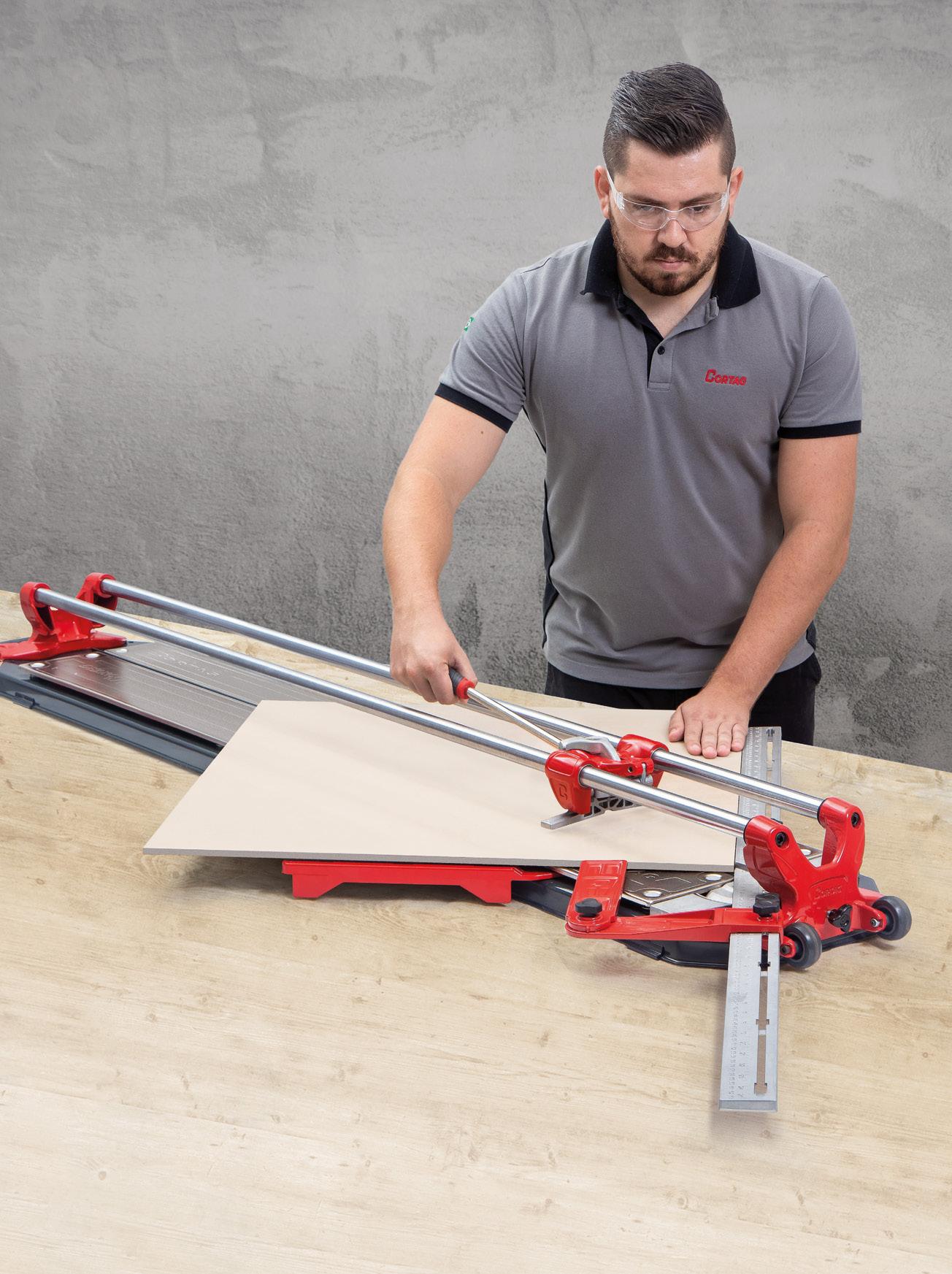
The tenth edition of the study entitled “World production and consumption of ceramic tiles” produced by MECS / Acimac Research Centre was published
in October. Consisting of almost 300 pages of charts, tables and commentary, the study provides detailed analysis of the trends occurring over the ten-year period
to 2021 in terms of industry, markets, per capita consumption and export flows in geographical macro-regions and in the 76 largest tile producer, consumer, exporter
1) The year 2021 saw a sharp acceleration in the pace of recovery of global tile production and consumption volumes which had begun in 2020, and above all brought a significant increase in import-export flows (+8.7%) following the previous year’s decline.
2) In 2021, world tile production reached 18,339 million sqm, up 7.2% from the 17,101 million sqm recorded in 2020. Production in Asia grew by 4.9% to 13.6 billion sqm, equivalent to 74% of global production. this positive result was mainly due to the increase in volumes produced in China, India and Indonesia, which offset the sharp contraction experienced in Vietnam. The European continent produced a total of 2,124 million sqm (11.6% of world production). Production saw double-digit growth both in the European Union (+18% to 1,393 million sqm) and in nonEU Europe (+14.6% to 731 million sqm) driven by the sharp increase in Turkey. Production in the American continent grew strongly to 1,737 million sqm. The growth rate in North America was 17.4% (377 million sqm), while Central and South America saw the biggest increase, +24.5% to 1,360 million sqm. The only area to experience a contraction in 2021 was Africa, where production dropped to 888 million sqm (-3.3%) due to steep declines in Algeria and to a lesser extent Nigeria which outweighed the increases in all other countries on the continent.
3) In 2021, world tile consumption grew from 17,050 to 18,209 million sqm (+6.8%). All global regions saw a recovery. In Asia, consumption rose to 13.2 billion sqm (+5.2%), equivalent to 72.3% of the world total. In Europe, consumption increased both in European Union countries (1,141 million sqm; +14.2%) and in non-EU Europe (649 million sqm; +15.3%). The Americas saw growth both in Central and South America (1,448 million sqm; +16.4%) and in North America (603 million sqm; +11.5%). Demand in Africa also increased, reaching 1,148 million sqm (+1.5%).
4) In 2021, global exports rose by 8.7% to 3 billion sqm, approximately 244 million sqm more than in 2020. Here too, the recovery involved all geographical areas. Asia’s exports grew to 1,414 million sqm (+2%), equivalent to 47% of the world total. The European Union’s exports rose sharply (1,055 million sqm; +14.3%) and amounted to 35% of the global total. Non-EU European countries also performed well (231 million sqm; +12.3%), largely due to growth in Turkish exports. Exports also grew in Central and South America (183 million sqm; +36.3%), North America (45 million sqm; +10.7%) and Africa (85 million sqm; +4.6%).
OTHER
CENTRAL-SOUTH AMERICA 1.360 7,4% 24,5% ASIA 13.585 74,1% 4,9% AFRICA 888 4,8% -3,3% OCEANIA 5 0,0% 0,0% TOTAL 18.339 100,0% 7,2%
AREAS
EUROPEAN UNION (27) 1,141 6.3% 14.2%
OTHER EUROPE (Turkey included) 649 3,6% 14.2%
NORTH AMERICA (Mexico included) 603 3,3% 11.5%
CENTRAL-SOUTH AMERICA 1,448 8,0% 16,4%
ASIA 1,448 72.3% 5,2%
AFRICA 1,448 6,3% 1,5%
OCEANIA 54 0,3% -0,5% TOTAL 18,209 100,0% 6,8%
and importer countries.
The major new feature of this year’s study is the in-depth review of the 10-year historical series for
production and consumption in

or macro-regions, the European Union remained the area with the highest export share in 2021 at 75.7% of its production. All the other areas lagged well behind: nonEU Europe exported 31.6% of its output volumes, North America 11.9%, South America 13.4%, Asia 10.4% and Africa 9.6%.
The trend in import/export flows confirms the tendency for tiles to be produced close to markets. Although world exports represented 16.4% of production and 16.5% of global consumption in 2021, 62.1% of this volume consisted of exports shipped within the same geographical region as that of production (for example, 81.4% of South America’s exports remained in South America, 82.2% of North America’s exports were sold within the NAFTA region, and 70.5% of Asian exports were shipped to other Asian countries). The European Union continued to be a partial exception with 45.4% of its exports sold in non-EU markets.
This analysis is confirmed by the fact that the shares of world production and consumption tend to be similar in each continent. Asia accounted for 74% of production and 72.3% of world consumption, Europe (EU + non-EU) 11.6% and 10% respectively, the Americas 9.5% and 11.3%, and Africa 4.8% and 6.3%.
6) As the world’s largest producer, consumer and exporter of ceramic tiles, China saw a 4.6% increase in production in 2021 to 8,863 million sqm (640 million sqm more
than in 2019 prior to the pandemic), accounting for 48.3% of global production. As reported in the MECS study entitled “China: Ceramic tiles and slabs”, in 2020 the country’s installed capacity reached 12.4 billion sqm across 2,275 lines operated by 1,161 companies or groups. China continued to record particularly strong growth in the large slab segment, which according to CTW estimates comprises some 100 dedicated production lines but is showing signs of overcapacity.
In 2021, Chinese tile consumption grew by 5.2% from 7,859 to 8,268 million sqm, accounting for 45.4% of the world total.
After peaking at 1.15 billion sqm in 2013, Chinese exports continued to decline for the eighth consecutive year, falling from 622 to 601 million sqm (-3.5%) and amounting to 20% of world exports. China’s exports grew in Asia (427 million sqm; +3.8%) and Oceania (36.5 million sqm; +5.2%), remained stable in Latin America (56.8 million sqm), and continued to contract in other areas: -32% in Africa (61 million sqm); -11% in North America (10.7 million sqm); -59.3% in the European Union (3.3 million sqm) and -38% in the rest of Europe (5 million sqm). The average selling price of exported Chinese tiles remained stable at around 5.7 €/sqm.
panies operating in the Morbi district in Gujarat alone was able to determine their real contribution to national output, which was found to be far greater than reported in the official sources used until now for this study. This prompted a major revision of the ten-year time series for the Indian industry and market. In 2021, total production in India grew by 10% from 2,318 to 2,550 million sqm. Domestic consumption saw a similar increase (around 2 billion sqm), driven by a surge in construction work following the slowdown in activity caused by the pandemic. Despite a 10.6% increase in exports to 483 million sqm, India has dropped to third place in the ranking of the world’s largest exporters after being once again overtaken by Spain. India’s exports now account for 16% of the world total and 19% of domestic production. In value terms, exports reached €1,486 million, equivalent to an average selling price of 3.1 €/sqm, which remains one of the lowest values of any major exporter country.
Saudi Arabia retained its position as the Indian tile industry’s largest export market, despite the fact that import duties on Indian tiles introduced in the GCC countries caused sales to plummet by 50.5% from 91 to 45 million sqm.
This contrasted with a growth in sales in all the other main export markets: Kuwait (35 million sqm; +96%), Iraq (26 million sqm; +13.5%), United Arab Emirates (23 million sqm; +12.5%), Nepal (20 million sqm; +46%), the United States (20 million sqm; +8.6%) and Mexico (18 million sqm; +7.5%). Amongst the biggest increases were the twofold growth in exports to Russia (11.2 million sqm), a 1000% surge in exports to the Philippines (from less than one million sqm to 10.7 million sqm), and a 427% rise in exports to Jordan (9.7 million sqm).
Overall, the Asian continent absorbed 57% of India’s exports (274 million sqm; +1.6%), Africa 16% (77.4 million sqm; +29%), North America (NAFTA) 8.7% (42 million sqm; +8.2%), Europe (EU + non-EU) 13% (63 million sqm; +26%) and South America 5% (24.4 million sqm; +60.7%).
8) The world’s third largest producer and consumer country in 2021 was Brazil, which more than made up for the losses of 2020 with an increase in production from 840 to 1,049 million sqm (+25%), while domestic demand continued to grow (902 million sqm; +8.8%), driven by the expansion in construction activity. Exports rose sharply to 128 million sqm (+33.8%) thanks to growth in all the main Latin American markets, while sales in the United States (the largest export market for Brazilian tiles) fell by 11% to 22 million sqm.
9) Spain, Europe’s top tile producer and the fourth largest producer country in the world, produced 587 million sqm in 2021, up 20.3% on 2020. The country’s consumption increased to 182 million sqm (+26.4%) and was almost entirely met by domestic production. In 2021, Spain also regained second place in the rankings of world exporters thanks to 17.4% growth in foreign sales to almost 500 million sqm (496 million sqm, to be precise), equivalent to 84.4% of its production. Export revenues increased by 24% to € 3,668 million, thanks to an increase in average price to € 7.4/sqm. Overall, Spain’s domestic sales and exports amounted to 667 million sqm in 2021, generating total revenues of €4,855 million.
France maintained its position as the largest export market in terms of volume (51 million sqm; +16.7%) and the second largest in value (€400 million; +17.9%); followed by the United States with 49 million sqm (+13.6%) and a value of €447 million (+23%); Morocco (24 million sqm; +17%), Israel (23.5 million sqm; +45.7%) and the United Kingdom (22.7 million sqm, -2.7%). Exports to Saudi Arabia experienced a sharper decline, falling by 23% to 16.6 million sqm.
In 2021, Spanish exports in volume terms were divided up as follows: 42.6% in Europe (211 million sqm), 22.2% in the Americas (110 million sqm; +38.9%), 18.5% in Asia (91.4 million sqm; -4.6%) and 16.2% in Africa (80.2 million sqm; +15.6%).
10) In 2021, Italy posted record performances across all indicators. Production surged to 435 million sqm (+26.5%) and total sales rose to 455 million sqm (+16.4%), generating revenue of €6.2 billion (+20.1%). The domestic market regained 15 million sqm as sales rose to 91.2 million sqm (+24.4%), corresponding to a value of €967 million and an average price of 10.6 €/sqm. Adding in imports (32 million sqm), domestic consumption reached 123 million sqm.
Italy remained the world’s fourth largest exporter, closing 2021 with exports of 364 million sqm (+14.6%) and revenues of €5.2 billion (+18%), largely due to an increase in average price to 14.3 €/sqm.
The Italian tile industry further strengthened its position in European markets, where it sold 258 million sqm (equivalent to 71% of exports in volume), including 234 million sqm in EU countries (+14.5%). Sales also grew in the other geographical regions declined: +16% in the Americas (52.8 million sqm), +16.5% in Asia (34 million sqm) and +4.2% in Africa (13.7 million sqm).
The rankings of Italy’s largest export markets remained unchanged. Germany was again the largest market with 64 million sqm (+6.2%), followed by France (53.8 million sqm; +18.4%), the United States (38.4 million sqm; +17.6%), Austria, Belgium, the UK and Switzerland, all with positive growth figures.
11) The two Asian giants China and India and the two largest European producers Spain and Italy together accounted for 64.5% of global exports last year. When the other 6 major exporting countries are included, the figure rises to 84.9%. Spain and Italy confirmed their leadership position in terms of export share, respectively 84.4% and 83.6% of production, compared to 57% for the UAE, 56% for Poland, 40% for Iran, 35% for Turkey, 19% for India and just 7% for China. In addition, Italy maintained its leadership in terms of average selling price at 14.3 €/sqm compared to the 7.4 €/sqm of Spain, the 6.4 €/sqm of Poland and the 5.7 €/sqm of China.
12) Indonesia and Vietnam remained the largest producer and consumer countries in the Far East, while Iran retained its dominant position in the Middle East. In 2021, Indonesia recorded a 35% increase in production (410 million sqm), driven by a similar increase in domestic consumption (478 million sqm; +34%); imports also increased by 17% to 85 million sqm. By contrast, Vietnam saw a further sharp decline in production from 534 to 370 million sqm (-31%) and in domestic consumption (300 million sqm; -25%) due to the continuation of the pandemic lockdowns. Iran saw a 2% increase both in production (458 million sqm) and in exports (182 million sqm).
13) After reversing the downward trend in 2020, Turkey continued its growth trajectory in 2021 with a big increase in both production (up 18.4% from 370 million sqm to 438 million sqm) and domestic consumption (up 21% to 291 million sqm). Its exports also continued to grow, climbing by 17% to 154 million sqm, corresponding to a value of €829 million. Turkey’s exports were mainly shipped to three macro-regions: 44% to the EU (68.4 million sqm, +12%), 23% to the Middle East and Asia (35.6 million sqm; +17.8%) and 21.7% to the NAFTA region (33.4 million sqm; +14%). The USA maintained its position as the largest single export market for Turkish tiles with a further 16% increase over 2020 to 27.2 million sqm. Next came Germany (18.8 million sqm; +5%), Israel (18 million sqm; +27.2%) and the UK (14.7 million sqm; +12.6%).
14)In 2021, the 10 largest importer countries imported a total of 1,155 million sqm (up 4.6% on 2020) and accounted for 38.3% of global import/export flows. For most of these countries, imports met more than 72% of domestic demand, with peaks of 98% in Iraq and between 90% and 95% in France, Germany, Israel and the UK. Notable exceptions included Indonesia, which im-
ported just 18% of its consumption, and Saudi Arabia where imports contracted significantly in 2021 from 167 to 105 million sqm (-37.3%) and accounted for 41.5% of national consumption. The fall in Saudi Arabia’s imports was due not so much to the contraction in domestic demand (252 million sqm; -11%) as to the sharp growth of the domestic ceramic tile industry, which increased its production from 99 to 150 million sqm in the space of two years (corresponding to annual growth of 26%). The biggest exporters to Saudi Arabia remained India (which, as mentioned above, saw its sales halved to 45 million sqm), the United Arab Emirates (28 million sqm; -5.4%) and Spain (16.6 million sqm; -23%), followed by
Oman, China and Egypt, which each saw declines of between 40% and 50%.
15) The United States remained firmly at the top of the global tile importer rankings with a 9.5% increase in imports to 215 million sqm, in line with a corresponding increase in domestic demand (289 million sqm) and stable at 74.5% of domestic consumption. 88.7% of US imports originated from the 6 largest supplier countries: Spain (49.3 million sqm; +13.6%), Italy (38.4 million sqm; +17.6%), Mexico (33.4 million sqm; +5.7%), Turkey (27.2 million sqm; +15.8%), Brazil (22 million sqm; -11.5%) and India (20.2 million sqm; +8.6%). ✕
1. CHINA 854 779 622 622 6.8% 19.9% -3.5% 3.453 5.7 2. SPAIN 414 415 422 496 84,4% 16.5% 17.4% 3.668 7.4
INDIA 274 359 437 483 18,9% 16.0% 10.6% 1.486 3.1
ITALY 328 323 318 364 83,6% 12.1% 14.3% 5.199 14.3
IRAN 150 162 179 182 39,8% 6.1% 2.1% 198 1.1
TURKEY 99 112 132 154 35,2% 5.1% 17.1% 829 5.4
BRAZIL 106 101 96 128 12,2% 4.3% 33.8% 413 3.2
POLAND 43 50 58 62 55.9% 2.1% 7.1% 394 6.4 9. UAE 43 45 52 48 57,1% 1.6% -8.3% 184 3.9 10. MEXICO 46 41 37 41 14,1% 1.3% 9.8% 211 5.2 TOTAL 2,356 2,387 2,352 2,558 17.2% 84.9% 8,8% TOTAL WORLD 2,815 2,831 2,771 3,013 16,4% 100,0% 8,7%
Source: Mecs / Acimac Research dept. “World production and consumption of ceramic tiles”, 10th edition 2022







The ProfMedica Clinic in Poznan, Poland, was designed by the interior design firm Pulva, with a number of distinctive features in mind: “Our objective for the interior design was to convey a sense of comfort, including visual comfort, in a way that was far-removed from the aseptic feel usually associated with hospital facilities. We aimed for absolute minimalism, but with soft, focused lighting and, most importantly, artworks, to give the space personality.”
In the lobby, for example, there is a huge sculptural wall behind the reception desk, and the entire building is imbued with a professional, and yet warm and elegant atmosphere that is light-years from the aseptic styling typically found in healthcare facilities.
At the entrance there is a large lobby, whose aesthetics are amplified by the choice of through-body porcelain floor tiling (which can also be found in the toilet areas) from the “Limestone” collection by Cotto d’Este, in Oyster dark grey.


This ceramic collection is inspired by the beauty of the seabed. Layered and set in stone by the patient work of water and time, it is recreated and interpreted in an elegantly contemporary new style, with subtle vein patterns and delicately shifting hues.
As well as for its undeniable aesthetic qualities, the interior designers picked this series because it belongs to the exclusive “PROTECT®” project and is therefore ideal for use in hospitals because its silver-ion antibacterial shield eliminates up to 99.9% of bacteria from its surface.
We met Marco Pasquali at Cersaie, just hours after the publication of a press release announcing that his company – founded by his father Franco Pasquali in 1976 in Vigodarzere (province of Padua)
Tile International: Wow! Big news!
and now operating production facilities in Italy and Poland and sales offices in France, Spain, Portugal, Germany, Czech Republic, Russia and the United Arab Emirates – had been acquired by

Mapei Group.
We exchanged a few words at the trade show, when the news was still hot off the press.
Although overwhelmed by the massive public response, the key
Marco Pasquali: Yes. We’re getting a lot of compliments, congratulations and questions about how we achieved this.
Tile International: I bet you are.
What prompted you to make this decision?
M. Pasquali: Profilpas is a family business firmly rooted in hard work, a forward-looking vision, respect for its workforce, care for the environment, a passion for
its products and a commitment to continuously develop them.
We have grown steadily over the years and won significant market shares: we export our products to 70 countries, and exports account for no less than 60% of our turnover.
With a workforce of 160 employees, it was time to take things to the next level and step up our international presence again.
players were clearly proud of the achievement, as they stood surrounded by the company’s latest products and crowds of visitors, who had been flocking to the Profilpas stand since early morning.

We were hungry for the future, and we needed a partner to get us where we wanted to go.
Tile International: So the opportunity arose in the shape of Mapei Group?

M. Pasquali: Yes. We wanted more, for the growth of our business and the future of our employees. Mapei’s takeover bid fulfilled our wishes exactly, because we wanted to pass the baton of our hard work onto a com-
 Chiara Bruzzichelli c.bruzzichelli@tiledizioni.it
Chiara Bruzzichelli c.bruzzichelli@tiledizioni.it
pany that was solid, structured and international in reach, but at the same time family-operated and built on the same values as ours.
Our membership of Mapei Group will enable us to break into new markets, and will open doors for us worldwide, so that we can make further investments in both design and technology.
Integrating our products into the range offered by Mapei, which for years has been acquiring companies with know-how that complements their own long-standing products, in order to extend their offering and strengthen their market position, will also open up new possibilities for technological development.
Tile International: There must be swarms of ideas buzzing around in your head at the moment…
Technical and finishing profiles for all types of floor and wall coverings (ceramic, marble, wood, laminate, LVT and carpet) are our company’s core business, and are obviously the perfect complement to Mapei’s ranges. Over the years, Profilpas has extended its production to include skirting boards, bathroom systems and ducting, illuminated profiles, profiles for balconies, terraces and staircases, and installation accessories… all in a wide range of materials, spanning
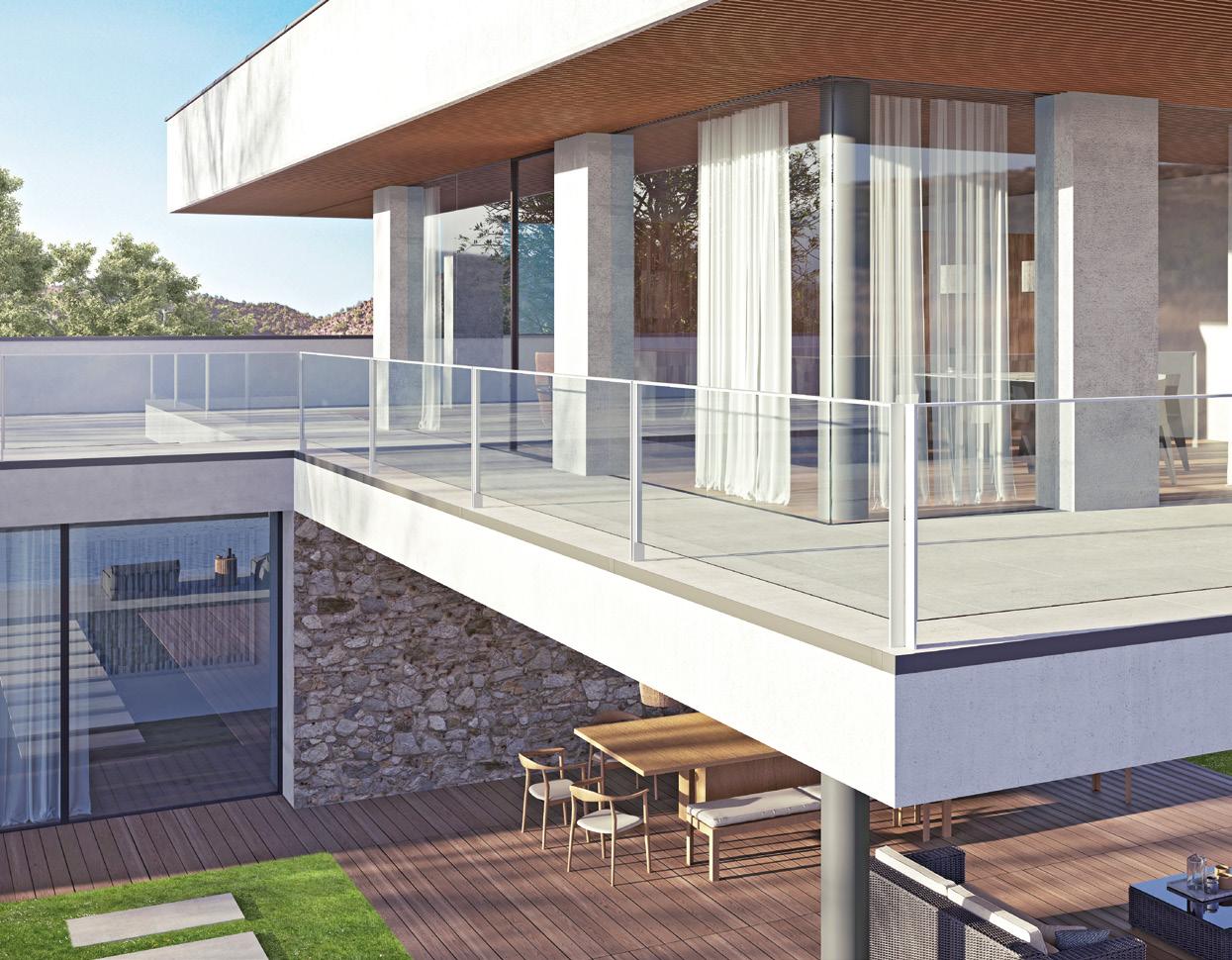
Each of these products will find new applications, developments and solutions once they become part of the macro-system of Mapei installation products. All we have to do is invent!
Tile International: What is the initial reaction to this news?

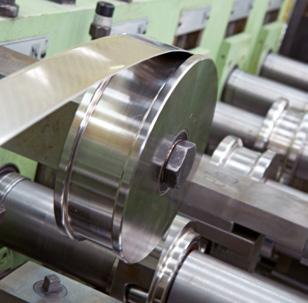
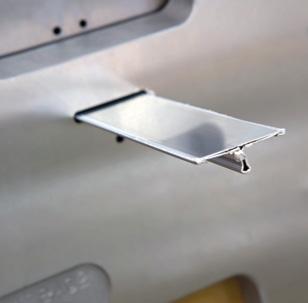
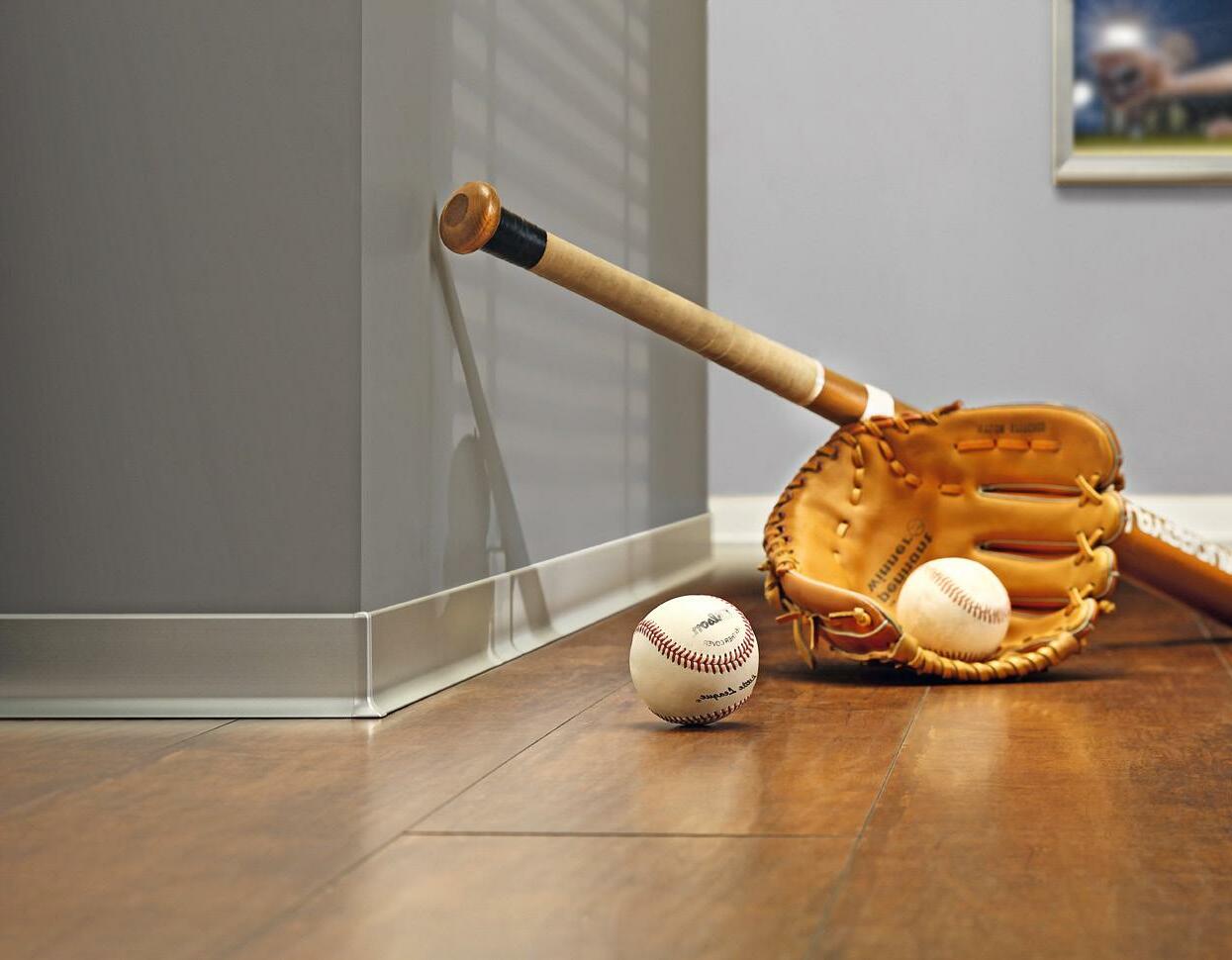
M. Pasquali: It’s still very fresh. There’s clearly a lot of enthusiasm from outsiders. We’ve received a lot of compliments and congratulations, because being singled out by such a prestigious company proves that our efforts have been worthwhile and brings certainty to our future plans for expansion and internationalisation.
Within the company, some of our staff were understandably concerned at first about the idea of being taken over by a multinational with 100 associate companies in 57 countries worldwide, and 86 manufacturing plants employing over 11,000 people. But their fears were assuaged as soon as they realised that the “Mapei philosophy” has always been based on respect for workers and on values such as loyalty, commitment and care for the environment. What’s more, all our employees were quick to see the added value of being part of an extremely strong Industrial Group that will take us into the future.
Tile International: Do you have any ideas yet about what your next steps might be?
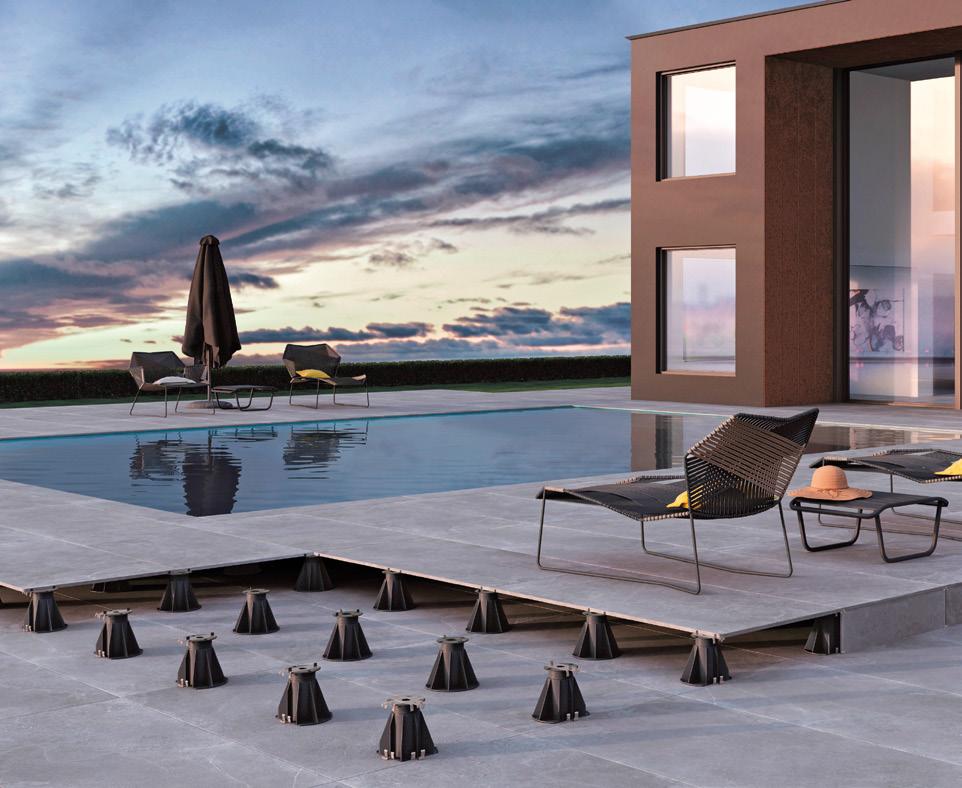
M. Pasquali: Internationalisation and market expansion are still our main goals. At this early running-in
stage, we intend to make our know-how available and gradually merge our plans and skills, while upholding our commitment to care for the environment and for our staff. ✕
With a view to sharpening its competitive edge in terms of products and markets, Mapei Group has stepped up its presence in Italy and abroad with a number of major acquisitions.
In 2018 it acquired Fili & Forme, a specialist manufacturer of synthetic structural macro-fibres for reinforcing mortar and concrete, which are sold under the Istrice brand. It also acquired Tecnopol Sistemas, a leading Spanish manufacturer and distributor of waterproofing and insulation systems for the construction industry, with an international presence spanning Europe, Latin America, the Middle East and Asia.
In January 2022, operating through its French branch, Mapei acquired Resipoly Chrysor, France’s leading producer of synthetic resins, and the latter’s subsidiary, Eurosyntec.
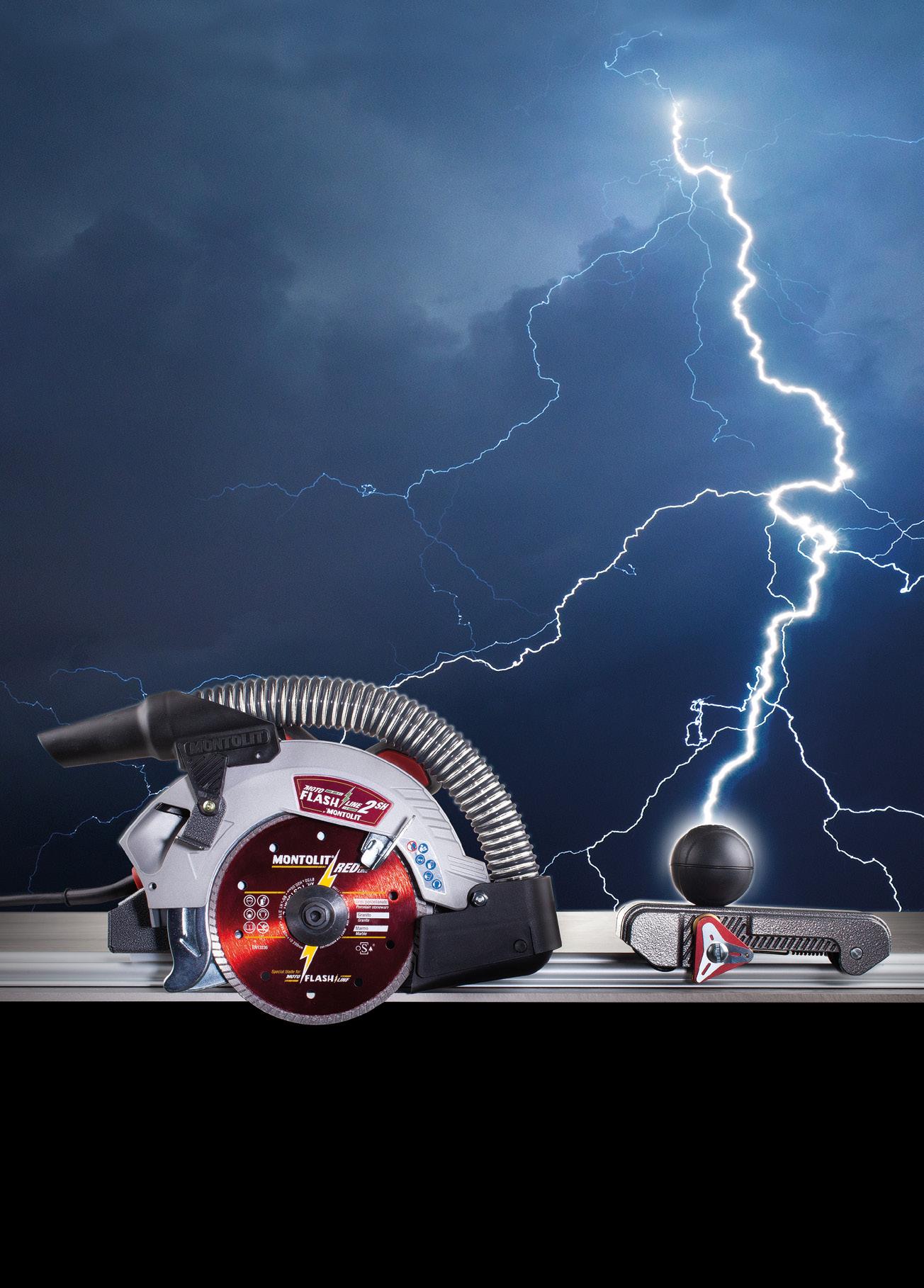

Just a few months after finalising an agreement to acquire Mexican company Vitromex (the transaction is expected to close in the first half of 2023, subject to government
approvals), Mohawk Industries is looking to expand further in Brazil, where it has already been operating since 2018 through Eliane. On 3 November, the group announced
Following this latest transaction, which is expected to close in the first quarter of 2023, Mohawk Industries will become the largest ceramic tile producer by value in Brazil. The synergies generated by Eliane and Elizabeth’s combined business will leverage their respective strengths, enhancing the product offering, operational efficiencies and service capabilities.
Once finalised, the acquisitions of Vitromex and Elizabeth will bring the American flooring multinational an additional capacity of around a hundred million square metres, further enhancing its position as the world leader in the ceramic tile sector.
The Calhoun-based group’s third-quarter results to 1 October showed the first signs of slackening growth due to weaker demand and a general increase in costs. As chairman and CEO Jeffrey S. Lorberbaum noted, “Mohawk’s third quarter sales [$2.9 billion, an increase of 3.6% on the third quarter of 2021 as reported and 8.3% on a constant basis - Ed.] increased primarily from price increases and strength in the commercial sector. Our sales were weaker than we anticipated, as the retail channel softened across all regions and product categories. Our operating income declined as lower volume resulted in higher unabsorbed cost and material, energy and transportation inflation impacted our results.”

Overall, Mohawk Industries posted sales of $9.1 billion in the first nine months of 2022, an increase of 7.7% versus prior year as reported or 12.1% on a constant basis, while adjusted net earnings (excluding non-cash impairment charges and other non-recurring charges) fell to $739 million compared to $844 million in the first 9 months of 2021.
Operations in Europe have been impacted more than elsewhere due to the unprecedented energy crisis and high inflation, while pricing has failed to keep up with the increases in costs. Lorberbaum notes that the high cost of energy has forced European consumers to concentrate on necessities and defer discretionary purchases, so sales and margins in the market will re-
an agreement to purchase Elizabeth Revestimentos, a company founded in 1984 in Joao Pessoa in the state of Paraiba. Elizabeth has four manufacturing units located strategically
main under pressure until the region overcomes these challenges.
The biggest obstacles in the US are high inflation and mortgage rates that have risen from below 3% to approximately 7%. Here, explains Lorberbaum, “the residential market is expected to decline further, including remodelling which has slowed in recent months. However, a long-term recovery is expected as the US has a housing deficit of five million units, and more than half of US homes are over 50 years old.”
Despite strong headwinds in Europe, the Global Ceramic segment delivered the strongest operating performance in the third quarter of 2022 and the first nine months of the year as a whole. In the period July-September, net sales grew by 9.8% as reported to $1.1 billion (12.4% on a constant basis) while adjusted operating margin was 12.1%. Total revenue for the nine
throughout the country to optimise distribution: two for the production of porcelain tiles in the State of Paraiba and two for the production of ceramic tiles in Criciuma (Santa
Catarina) and Goianinha (Rio Grande do Norte). One of the top 25 companies in Ceramic World Review’s ranking of the world’s largest tile producers, Elizabeth declared
a production capacity of approximately 56 million square metres and an actual output of 42.8 million square metres in 2021, as well as revenues of €197.5 million.
months reached $3.32 billion, an increase of 11.9% over 2021 and a 36.5% share of the group’s consolidated revenues.
Sales in the new home construction channel were solid in most geographies, and the commercial channel showed resilience with new construction and remodelling projects continuing.
As already mentioned, residential remodelling slowed in most markets due to tightening consumer discretionary spending and higher interest rates.
Sales in the US ceramic business expanded during the quarter, with high-end quartz countertop sales growing due to the introduction of new higher-margin collections that offer an alternative to European imports.
The European ceramic results exceeded expectations due to sales and pricing actions, a positive mix and Italian energy subsidies. Sales of premium collections remained strong, while increased gas prices impacted sales of outdoor and lower-end products.

All businesses are reducing production in the fourth quarter, reported Lorberbaum
As for the group’s other divisions, in the first nine months of 2022 the Flooring North America segment saw a 5.2% increase in sales to $3.26 billion, while the Flooring Rest of the World segment posted a 5.6% increase to $2.5 billion, despite a decline in the third quarter (down 4.8% on Q3 2021).
Given the impossibility of predicting the duration of current economic conditions and their impact on the industry, Mohawk Industries is focusing on investments aimed at maximising long-term profitability. The group expects to see slacker demand in the fourth quarter of 2022, prompting the decision to reduce production volumes while adopting a series of actions to enhance sales (increasing promotional activity, introducing differentiated collections and reacting to competitive actions) and lower administrative and manufacturing costs.
Lorberbaum’s outlook for the future remains positive: “During past decades, Mohawk has successfully managed through many challenging periods and industry recessions. The fundamentals of our business remain strong, and flooring remains an essential component of all new construction and remodelling. Mohawk has built leading positions in key markets around the globe with well-known brands and an extensive product offering. During this period, we are investing for the market rebound that always occurs after our industry con-
tracts. We are expanding our higher growth categories of LVT, laminate, quartz countertops, premium ceramic and insulation.

“We have also made strategic acquisitions that bolt on to our businesses and create significant synergies. Mohawk has a strong balance sheet with low net debt leverage of 1.2 times EBITDA and available liquidity exceeding $1.8 billion to manage through the current environment and optimize the long-term results.” ✕

We reinvented the support for exterior elevated floors. The Pedestal Prime® adjustable support with head for tiles, for aluminium joist or the universal one for wooden joist is the most flexible, elegant and safe solution for terraces, decking and poolsides. The levelling performance of the tilting head, which is capable of compensating slopes up to 5%, allows the precision alignment of the entire floor surface without any accessories or devices.


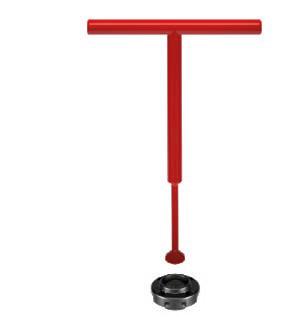



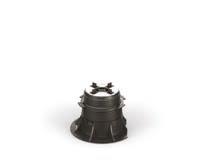
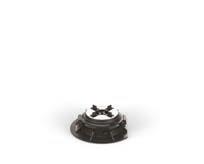
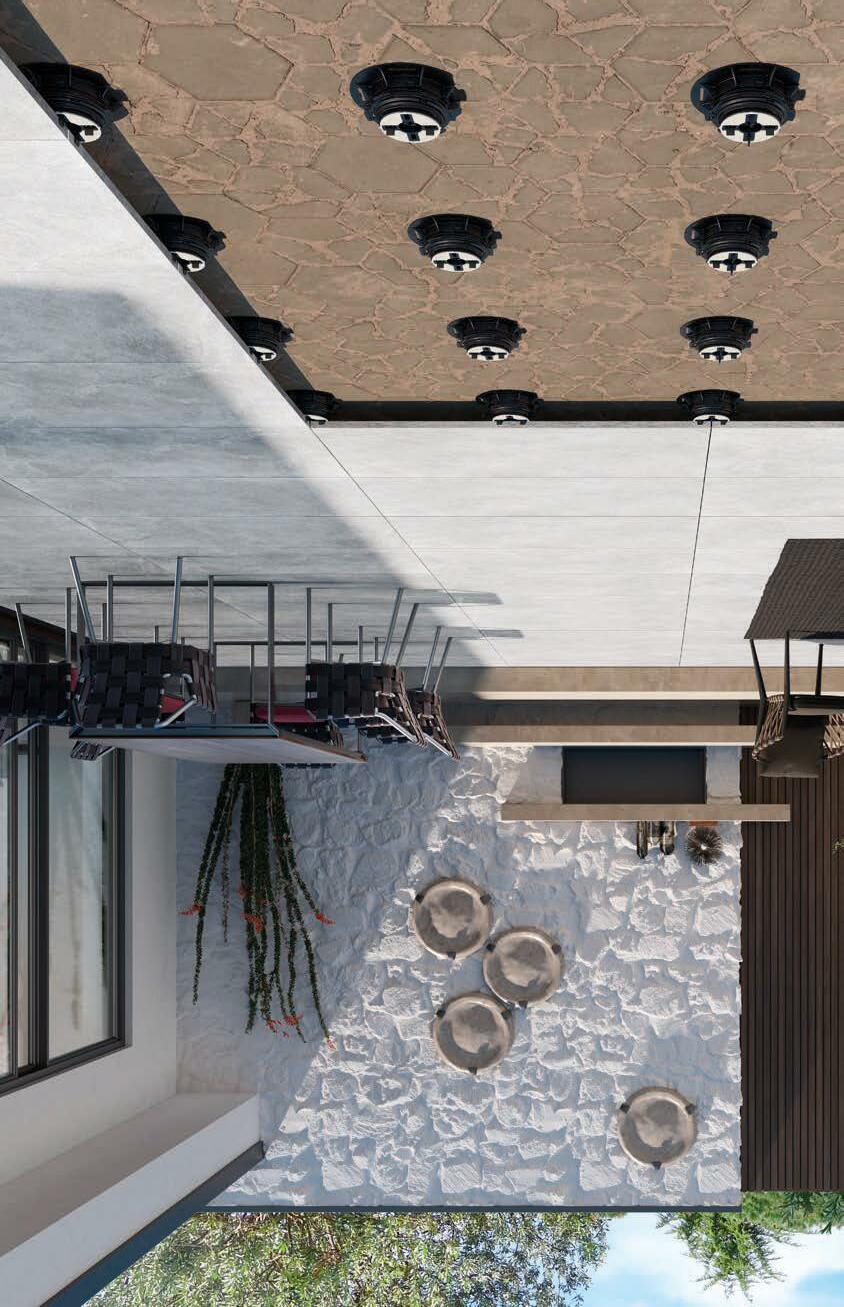



Kajaria Ceramics, India’s largest tile manufacturer and one of the top ten groups in the world, reported exceptional results in the fiscal year to 31 March 2022.
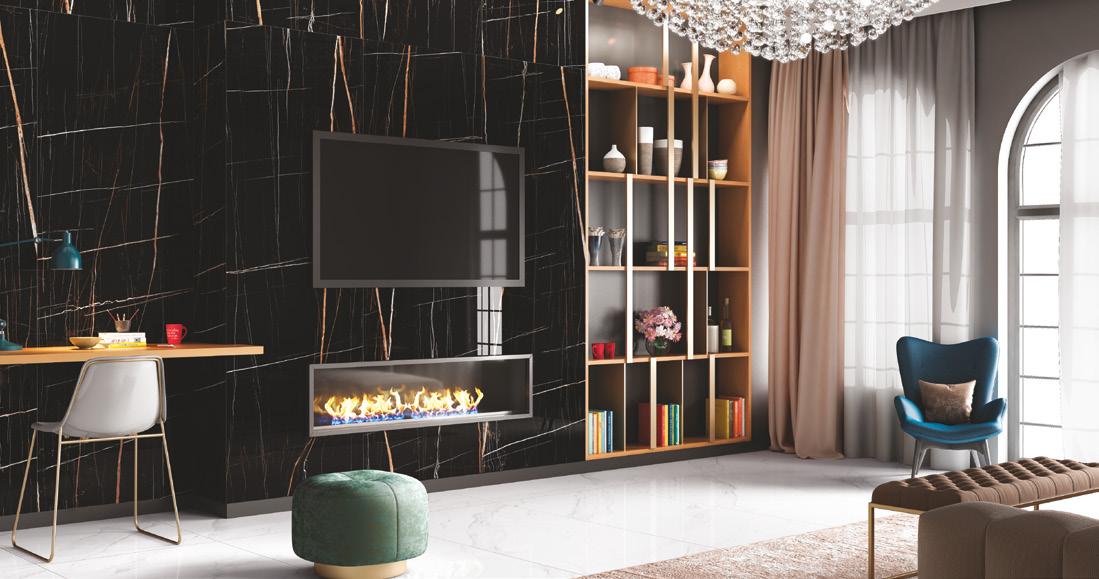
Total sales in volume grew 21% year-on-year to 92 million sqm,
while revenues were up 33% to Rs. 37.05 billion (approximately US $490 million).
The excellent performance continued in the first quarter of the new fiscal year (ended 30 June) with 80% year-on-year revenue growth
We met chairman Ashok Kajaria to discuss the group’s performance and future projects.
“We are highly satisfied with the performance we have delivered in FY22 and in Q1 FY23, which again demonstrated the power of sustainable business,” he said.
“Against a backdrop of geopolitical volatility and high commodity prices, the company has posted its highest ever sales volume of 91.67 million sqm (growth of 22% YoY) and 33% growth in revenues to more than Rs. 37 billion (around $490 million) in the financial year ended 2022. We continue to believe that the business momentum is going to be very strong on the back of increased traction in real estate sector, rapid urbanisation, consumer preference shifts and increased application of tiles in replacement and renovation projects.”
to Rs. 10.08 billion (around $133 million), representing the seventh straight quarter delivering doubledigit revenue growth.
EBITDA margin for the quarter remained stable at 15% despite escalating inflation across all inputs
Tile International: As you announced a year ago, you have completed a US $33 million investment plan, increasing your capacity to 82.8 million sqm. Could you tell us more about it?
Ashok Kajaria: As we plan to grow at a rate of 15% plus volume growth for the next 3 years, we need to increase our capacity either organically or inorganically. To meet these growth targets, last year we completed three brownfield expansions with a total of 12.4 million sqm/year. At our Rajasthan (Gailpur) Plant, North India, we started up a line with a capacity of 4.2 million sqm of floor tiles; at the Andhra Pradesh (Sri Kalahasti) Plant, South India, we have commissioned a capacity of 3.8 million sqm of value-added glazed vitrified tiles; a further 4.4 million square metre capacity of polished por-
and rising gas costs. Moreover, the group continues to maintain its focus on the domestic market (exports account for just 2% of volumes).
celain stoneware was added at the Kajaria vitrified tiles plant in Gujarat (Morbi), West India. This year, we have acquired a 51% stake in South Asian Ceramics Pvt. Ltd. Telangana, South India, which has an annual production capacity of 4.79 million sqm of ceramic floor tiles, to further strengthen our base in South India. This will take our total capacity to 87.59 million sq.m. Tile International: What are your forecasts for the development of the ceramic industry in India?
A. Kajaria: Today India is one of the fastest-growing ceramic tiles markets, especially for branded players. This momentum is likely to continue given the ongoing recovery of the real estate sector and increased spending on home and workspace beautification and appearance. We see accelerated traction not just from new projects but also from increased application of tiles in re-
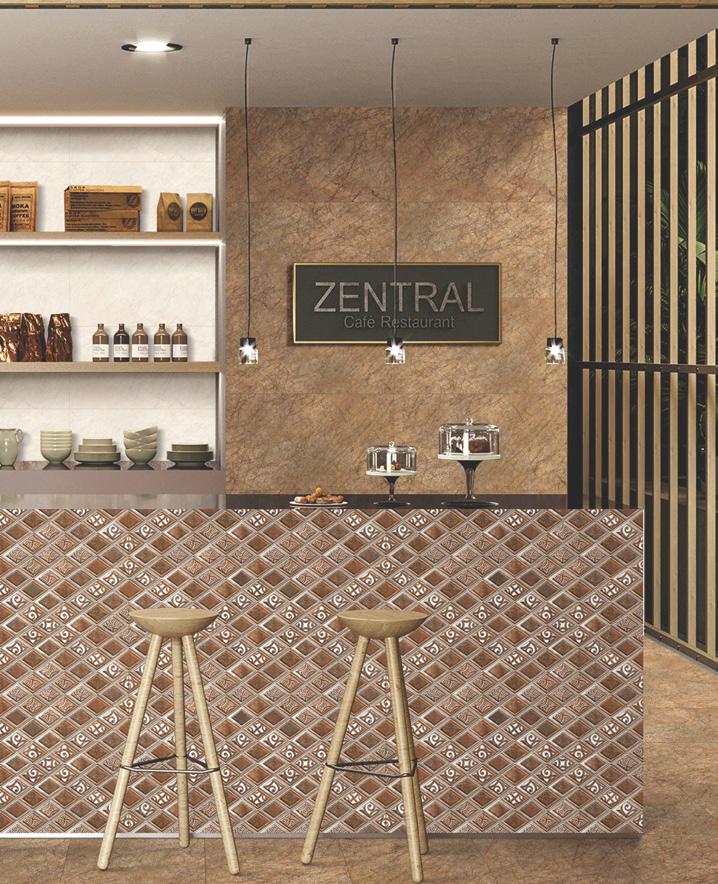
 Chiara Bruzzichelli c.bruzzichelli@tiledizioni.it
Chiara Bruzzichelli c.bruzzichelli@tiledizioni.it
placement and renovation projects. We remain optimistic about the future and expect the next financial year to be another strong year for our company.
Tile International: Where do you see the biggest challenges?
A. Kajaria: The biggest challenge that the ceramic industry is facing at the moment is the increase in gas prices and the fact that the sector is unable to pass the higher cost on to end users. Back in July and August 2021, the energy crisis began which caused supply shortages and huge spikes in fuel costs. This was followed by a surge in paper prices and freight costs and then the disruption due to current inflationary challenges resulting from the geopolitical tensions in the Russia-Ukraine region.
However, despite these headwinds we have managed to keep our business on track and continued to build confidence with our customers.
Though the rising gas prices and commodity cost inflation pose a near term pressure on operating margins, our price hikes will partially mitigate these cost pressures.
Tile International: Although you are not an export-oriented compa-

ny, what is your assessment of Indian industry’s growth in foreign markets?
A. Kajaria: In the current scenario, Indian tile exports look very promising.
We expect total exports to grow by between 33% and 40% this year to almost Rs. 170 billion (more than $2 billion). The export market has really opened up as India manufactures high-grade tiles using the latest technology and has the lowest cost of production amongst all the exporting countries. The pandemic and the resultant global supply chain disruption opened up new markets for Indian tile manufacturers, particularly the USA and the EU. This also helped to compensate for losses caused by the imposition of anti-dumping duty by the Gulf Corporation Council (GCC).
Tile International: You said you are optimistic. What are your expectations for the current year?
A. Kajaria: Kajaria Ceramics is capable, scalable and sustainable and is well positioned to face challenges and leverage opportunities. We will continue to explore ways to further improve our top line growth and profitability by capitalising on the favourable situations we have in our growing market.

Somany Ceramics is currently in a capacity expansion mode.

In May this year, the Indian Group completed the most important capacity expansion project in its recent history.
The three new lines increased
the group’s access to annual production capacity from 63 to 74 million sqm, strengthening its position as India’s second largest manufacturer and a top global player. As Managing Director & CEO Abhishek Somany explains,
The positive results were mainly due to the good trend in sales spread over the financial year. The construction market in India is buoyant and the company is targeting a growth of 30-35% in this financial year.
We spoke to CEO Abhishek Somany and to Amit Bhatnagar, Head of International Business & Strategy.
Tile International: Six months on, what is the situation today?

Abhishek Somany: The Indian economy has fully returned to pre-pandemic levels. Inflationary pressures
“This expansion was essential to maintain the leadership position in the market and enhance the overall brand saliency”.
In the fiscal year ended in March 2022, the company’s total revenues (including 10%
are present, but India is perfectly positioned to lead the industry into the next decade. The government has also played an important role through schemes aimed at making the overall business environment more investment friendly. One of these is the PLI Production Linked Incentive scheme, a five-year multi-billion dollar programme to boost the growth of the country’s industry in both domestic and export-oriented sectors. In the light of this, I am convinced that India has the potential to become the world’s largest ceramic tile exporter over the next decade.
generated in the bathroom segment) grew by 27% on the previous year to Rs. 20.6 billion (approx. US $272 million), with EBIDTA margins of 9.9%.
Tile International: And how is Somany Ceramics performing?


A. Somany: Somany Ceramics’ growth has been robust despite starting out from a low base. Going forward, India and the rest of the world will see a slowdown caused by ge-
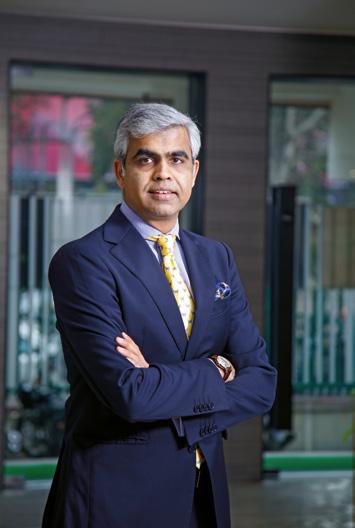 Chiara Bruzzichelli c.bruzzichelli@tiledizioni.it
Chiara Bruzzichelli c.bruzzichelli@tiledizioni.it
opolitical conflicts, although we are still confident of achieving a strong double-digit growth in the coming year. An important contribution will come from the capacity expansions we have completed in recent months, with approximately 20% capacity added to our existing three plants located in the north, south and west of the country (about 4 million sqm/year each). This expansion is for the production of various product types, from ceramic tiles to glazed vitrified tiles and technical porcelain tiles. In total, we now have an installed capacity of approximately 74 million sqm/year.
Tile International: What do you see as the biggest challenge?

A. Somany: The extreme volatility of natural gas prices – which in India have doubled in a year – and the consequent increase in all input costs, particularly raw materials, a problem common to the entire ceramic industry.
Tile International: What are the forecasts for the construction industry in India?
A. Somany: The residential and commercial construction sector has finally emerged from a decade of recession, and the sector is now seeing enormous growth across the country and is likely to continue at these levels for the foreseeable future. This is mainly due to government initiatives such as Housing for All and Clean India (Swachh Bharat) and the huge investments in highway construction which facilitates the de-
velopment of new urban centres.
Tile International: Let’s talk about the astonishing growth of Indian tile exports.
Amit Bhatnagar: Things are quite positive this year compared to last year’s difficulties caused by the availability and cost of sea freight. As a result, we expect India’s tile exports to grow by 45% in fiscal year 2022-2023 to approximately €2.2 billion. Freight costs to some destinations in Latin America and Europe are still quite high, but may decrease due to weaker global demand, which would make it easier to achieve the above-mentioned targets.
Tile International: Where are Somany Ceramics’ main export markets?
A. Bhatnagar: We currently have a presence in 70 countries, mostly in Europe, Africa and the Middle East, with an export share of 4-5% of total turnover. We are growing steadily in foreign markets by leveraging product quality and global brand strength and have a very different strategy and vision compared to the unorganized Morbi segment.
We aim to continue this growth by leveraging the same values that have guided our evolution in the Indian market over more than 50 years: quality, product innovation, reliability and the strength of one of the “Best Brands of India”, values that we pass on to our international clientele and which have enabled us to build rock-solid partnerships with our customers. ✕



To design a futuristic house with a sustainable character: this was the challenge taken up and overcome by the architect Santiago Martínez of

design, energy efficiency, functionality and a leading role for the natural setting, as the outdoors is ushered in by windows, porticoes and terraces.


Starting from two L-shaped rectangular prisms, the team at Estudio3 Arquitectos has designed a building that makes the most of the spectacular views afforded by its location. This structure supports a series of cubic volumes that house the bedrooms, where the Porcelanosa
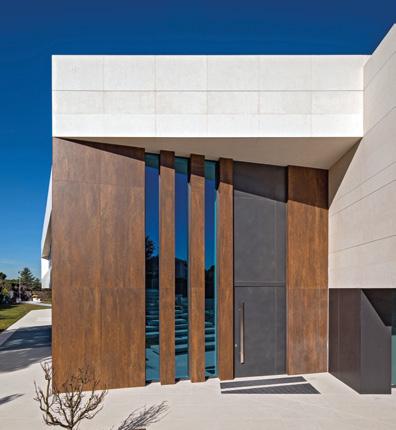

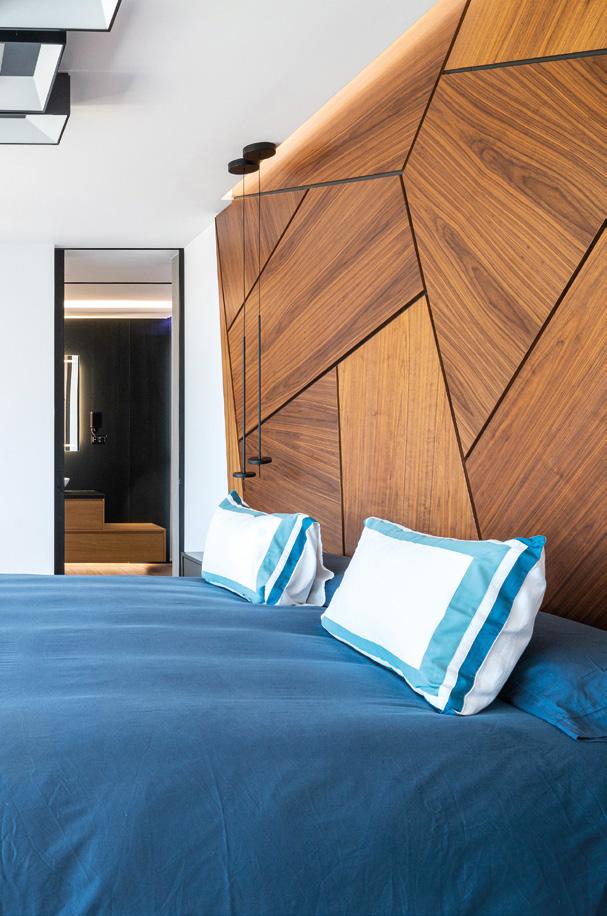
and XTONE extra-fine porcelain tile facade has been combined with Butech installation systems. These same materials have also been used inside the house as decorative coverings, while the connecting link between all the indoor environments is the PAR-KER® Tanzania Almond flooring by PORCELANOSA, which appears both in the private areas and in shared spaces such as
Chiara Bruzzichelli c.bruzzichelli@tiledizioni.it



the living-room, kitchen and bathrooms.
The Infinity Views residential complex has a distinctly eco-conscious soul due to the wide array of sustainability criteria taken into account during its construction. The correct orientation and bioclimatic design promote thermal stability, while optimising the entry of light and reducing electricity consumption. The choice of stone and porcelain tile for the walls, and technological glass for the doors and windows, provides the right degree of insulation to keep the temperature comfortable for a minimum of energy consumption. This is backed up by the use of renewable energy sources such as geothermal energy and solar panels, energy-efficient LED lighting systems and the installation
of direct digital controls for temperature, humidity and lighting. All these factors make the residence an exemplary high-performance building with low environmental impact.



The house enjoys particularly close links with its natural surroundings, which it integrates coherently into the interior, while retaining a distinctly modern look. This close link with the local geography is marked, for example, by the use of the Stuc White Texture collection by XTONE for all of the outdoor paving. The range of sandstone-inspired surfaces with nonslip finish, characterised by a solid, metallic effect, also generates a pleasing sense of aesthetic continuity between the floors, staircases, facade components, solarium and terraces. ✕
Located in the heart of San Martino di Castrozza, at the foot of the Trentino Dolomites in Italy, Hotel Letizia offers guests a welcoming setting, enhanced by the warmth of natural wood.
For the purposes of remodelling this mountain gem, the building contractor opted for the professionalism of Progress Profiles and the quality of their products, which were supplied by the local dealer, MG Pavimenti & Co (Trento).
For the outdoor raised flooring at the entrance to the hotel, the contractor used “PROSUPPORT TUBE SYSTEM”, which is ideal for quick, easy installation of


Built in a typically Alpine style, the hotel stands out for its attention to architectural detail, its wellness centre and its gourmet cuisine.
floating floors of heights ranging from 29mm to 1 metre, in conjunction with “PRORAIL SYSTEM”, which ensures the maximum stability of the coverings. This is especially necessary in a high-footfall area that is often exposed to heavy snow.
Raised flooring facilitates both water drainage and maintenance work on the underlying waterproofing system: Progress Profiles systems made it possible

to install the flooring to the highest professional standards, and to combine functionality with meticulous attention to detail.

The low-down
Suitable for use on any type of surface, “PROSUPPORT TUBE SYSTEM” consists of a base, a ring-nut, a screw,
two heads with removable 2mm- or 4mm-thick lugs and a set of tubes for achieving the desired height. The possibility of laying the flooring as a fixed or self-levelling system makes installation simple, practical and intuitive: if the screw is tightened with the concave side facing upwards, the head is self-levelling; if the screw is turned by 180°, the head is fixed.
Chiara Bruzzichelli c.bruzzichelli@tiledizioni.it
The “PRORAIL SYSTEM” consists of aluminium joists,
available in “Prorail” or “Prorail Ret” versions (shaped or plain respectively), a retaining ring known as the “Prorail Ring”, two “Prorail Spacers” with removable lugs,
and a noise-damping, anti-slip rubber pad known as the “Prorail Rubber”.
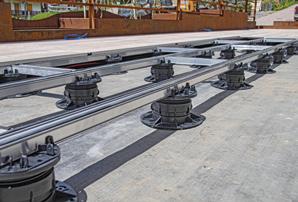

PROGRESS PROFILES: Progress Profiles is a family business with a history stretching back 37 years. With the handover to a new generation, it has evolved into a global enterprise with ever-growing revenues, thanks to over 30 years of constant Research & Development focused on the most innovative technologies and materials. With a production facility with an indoor area of over 16,000sq.m and a fleet of state-of-the-art instruments, the company is committed to producing innovative solutions for indoor and outdoor surface finishings for residential and commercial buildings. It also has a 200sq.m showroom and a fully equipped Training Area, to support the Training Academy.
In line with its proudly green credentials, Progress Profiles makes use of solar-powered heating and plumbing systems and a photovoltaic installation on the roof of the facility, for a total of 800 kWh, which meets over 60% of the company’s annual energy needs, thereby saving 390 tonnes of CO2 emissions per year. Holding ISO 9001:2015 - UNI EN ISO 9001:2015 certification, and committed to using top-grade materials in full compliance with REACH and GREENTOP requirements, the company has been rapidly expanding on the international stage for years, with the result that it now has three foreign subsidiaries (America, Middle East and Oceania) and a close-knit network of agents across 70 countries worldwide







The new “LATAM Lounge”, commissioned by the airline of the same name, replaces the Group’s VIP lounge and welcomes its most loyal passengers and members of partner companies as they wait for

With a surface area of 4,300m2, “LATAM Lounge” is now the largest airport lounge in South America. Undertaken in the midst of the pandemic by Grupo Arquitectos, the project focused on two priorities: showcasing the influences of Latin American design and embracing the cause of sustainable architecture, in line with LATAM Airlines’ commitment in all its activities.
their flights in a relaxing space that reinterprets the feel and colours of South America in an eco-sustainable way.
The Group was listed in Standard & Poor’s 2022 Sustainability Yearbook as the most sustainable airline in America (not just South America), Europe and Oceania, and it takes fourth place in this special league table at worldwide level. Launched in 2021, LATAM’s sustainability strategy reveals a profound commitment to protecting South American ecosystems and includes a process involving experts and environmental organ-
isations, aimed at achieving carbon neutrality for the Group by 2050.
The new lounge in Santiago de Chile was specifically designed and built with this in mind: 80% of its power consumption is covered by renewable energy sources and it features interactive games on issues relating to recycling, waste reduction and the re-use of waste.

LATAM Airlines is committed to offsetting its carbon
emissions through ecosystem conservation projects in South America.
From a conceptual point of view, the key word of the design is “reconnecting”. “The use of natural materials” explains Catalina Valdes, founder partner and principal architect of Grupo Arquitectos, “must be viewed through this lens, as a way of reconnecting with the essence.”
Chiara Bruzzichelli c.bruzzichelli@tiledizioni.it
The choice of the Laminam “I Naturali” porcelain tile series, in three different finishes, meets the need to establish an evocative and at the same time material link with the geographical area and its changing expressions. Three different lounges provide three independent spaces and three experiences, to be discovered one at a time through a progression that symbolises the transition from the stress and frenzy of travelling to the moment of reconnection.
The ability to bring unique value to the environments it covers has been deployed here through three products used for the floor and wall tiling, the suspended ceilings and the countertops, with “Laminam 5+” and “Laminam 12” thicknesses respectively, in order to obtain three similar spaces in terms of layout and material characteristics, but with different colours and atmospheres.
For the World Member Lounge, the designers opted for Bianco Statuario Venato with a polished finish, which echoes the palette of the Andes Mountains
Location: Santiago de Chile (CHILE)
Year: 2021- March 2022
Products used:
Bianco Statuario Venato Lucidato - I Naturali series
Noir Desir Lucidato - I Naturali series
Nero Greco Lucidato - I Naturali series
Seta Gris - Seta series
Seta Glacé - Seta series
Seta Liquorice - Seta series
thanks to its predominant white tone softened by purple and blue highlights.
The Signature Lounge evokes the desert that blooms only once a year and, thanks to the use of Nero Greco with a polished finish, is imbued with warm, seductive tones.
The Premium Lounge draws inspiration from the sea and its meeting with the land: a union that takes shape in the intense tone of Noir Desir.
The coverings of the entrances were created with the “Seta” collection, a Laminam line that stands out for its ability to take on different colours according to the reflected light.

The diversity of the entrance of the three lounges was thus expressed in three shades: Seta Gris in the World Member Lounge, Seta Glacé in the Premium Lounge and Seta Liquorice in the Signature Lounge, so as to elicit three different feelings of luminosity.

The same tones also characterise the lounges’ three bathrooms, including the bathroom countertop and
Thicknesses: Laminam 5+ (walls, suspended ceiling, wall details, furnishing complements) / Laminam 12 (counter, bathroom countertop)
Client: LATAM Airlines
Firm of Architects: Grupo Arquitectos https://grupoarquitectos.com/es/
Interior Design: Enrique Concha & Co. / Bruno Frugone https://tienda.enriqueconcha.com/
Laminam Chile Distributor: Bercia www.bercia.cl
furnishing complements, thus creating a stylistic common thread that underscores the project’s sophistication and attention to detail.
The possibility of using the same material for the wall coverings, floor coverings, exterior facades and even the interior design surfaces – the so-called “Laminam effect” – is the key factor that made it possible to create high-impact, profoundly evocative environments.
The new “LATAM Lounge” project was undertaken during the early part of the pandemic, which affected both the work processes – initially carried out remotely – and the choice of materials and the layout of the space.

“It was important for us that all spaces were Covid-free,” explains Jorge Hasbun, founder partner and principal architect of Grupo Arquitectos “In the bathrooms, for example, everything is touchless and the large surfaces give a stronger impression of cleanliness.” “Everything is real and pure, and purity helps un-
derscore the design concept behind every project, ” explains Hasbun.
Sustainability was crucial: LATAM specified that no leather should be used and that wood and plastics should be recycled or recyclable. Laminam made a major contribution in this respect too, because each area contains between 20% and 40% pre-consumer recycled material. The natural composition of the coverings means they are easy to grind and recycle at the pre-firing stage in other production cycles, and the LEED and BREEAM certifications are an additional guarantee of the material’s environmental sustainability
The new “LATAM Lounge” also showcases local culture with a permanent exhibition of sculptures by emerging South American artists, made from recycled materials as part of a commitment to upcycling. “It is our custom to incorporate art into our projects, ” explains Bruno Frugone. “There are over 60 works of art in these lounges, and we take great pride in this.” ✕
The radical change of the skyline of the Venetian coast through the Jesolo Lido Design District project has had several stages of implementation: the first, completed in 2007, ended with the construction of The Pool Houses village; the second, The Beach Houses, was completed with the construction of 74 sea view apartments in 2012. The most recent phase, The Summer Houses, was
completed in 2021 with the inauguration of two condominiums, one of seven and one of ten floors. In the future, it is planned the construction of three other residential complexes: The Beach Residences, The Tower and The Park Villas with the same architectural features, transparencies and large volumes, which, like the previous buildings, will represent the maximum expression of luxury.

cated to design, luxury and the search for an unforgettable experience: all harmonized by a common design phi-
The Summer Houses has two buildings, The Tower and The Gallery, which constitute the main and avant-garde elements of the entire project.
The buildings cover an area of 11,500 square meters, of which 3000 are dedicated to a relax area equipped with every comfort dedicated to well-being: SPA, five swimming pools, sauna, steam bath, green areas and solarium. We find the architectural elements that char-
acterize the whole quarter: bright windows and large terraces allow you to admire the panoramic view of the beach of the Adriatic Sea every day.
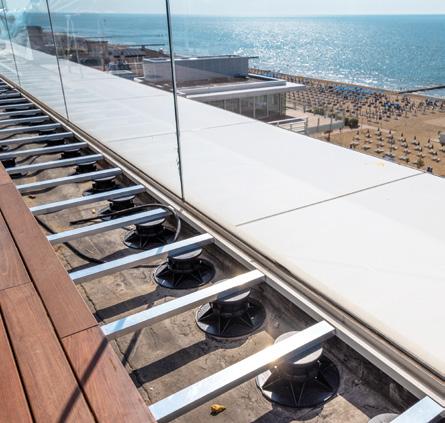

Chiara Bruzzichelli c.bruzzichelli@tiledizioni.it
The raised floors of the outdoor areas and of the numerous terraces of The Summer Houses were made

of decking laid on 40x20 mm joists and 23 000 Jack Supports from the PEDESTAL line by Impertek. Thanks to the many combinations of components, Jack supports, that belongs to the Pedestal Line range, allows you to realize any flooring with heights from 35 to 380 mm quickly and easily, enjoying great appreciation by the installers.


The Jack Supports are composed of bodies available in various heights and eight different types of heads


that allow you to lay floors both with tile finishes (thanks to the heads with 18 mm high and from 2 to 10 mm thick tabs) and wood/decking finishes (with flat, rectangular, square or circular heads for 40- or 60-mm joists).
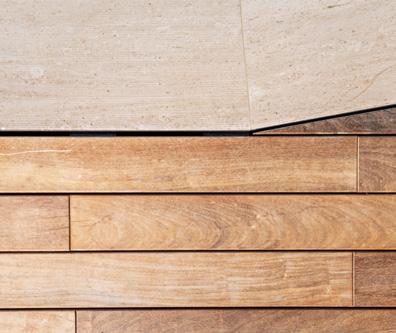
The Jack Supports have a load capacity up to 400 kg per unit: which correspond to 1,600 kg/sqm if distributed on 50x50 cm tiles and increase up to 2,500 kg /sqm with 40x40 cm tiles.

All Impertek supports have been designed for the installation of any type of flooring in ceramic, stone and decking, they are designed to adapt to all the installation needs that may arise on the construction sites and are produced with controlled plastic material recycled and recyclable again. ✕
PEDESTAL LINE is the most complete range of products for the construction of raised floors and is able to offer solutions for every construction need. Furthermore, all Impertek products defend environmental sustainability because they are made with recycled and recyclable materials once their life cycle is complete.

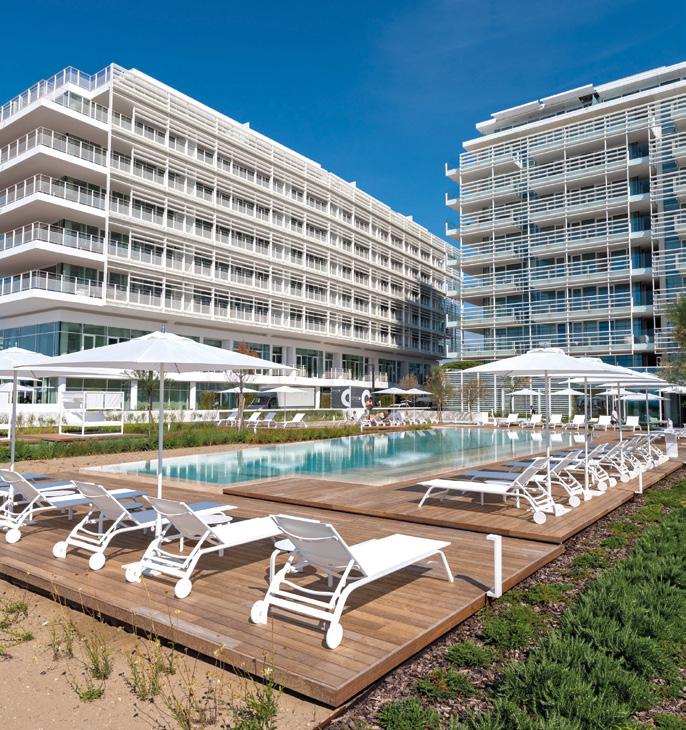
CROSS, a revolutionary new product from Cerdisa Ricchetti Group, made its world début at Coverings 2022 in April. This innovative finish combines technical and aesthetic


“CROSS” is a revolutionary new surface finishing technology for porcelain tile, with an R11 C slip rating. Suitable for both indoor and outdoor applications, it is tactile and easy to clean and maintain, thanks to its minimal dirt retention.
CROSS technology makes the Cerdisa and Ricchetti collections the ideal solution for any combined indoor and outdoor installation (kitchen
and shower, living-room and swimming pool, restaurant and panoramic terrace or indooroutdoor public spaces), by enabling architects to create aesthetically uniform and uninterrupted indoor-outdoor spaces.
Currently available for the Archisalt, EC1/22 (Cerdisa) and Neolitica (Ricchetti) series, the outstanding properties of CROSS, a smart surface finish, offer benefits that have never before been found together in
a single covering: softness and ease of cleaning, which are essential characteristics for indoor flooring, combined with an R11 C slip rating in both wet and dry conditions, which is an essential requirement for outdoor flooring.
Applied before firing, CROSS makes porcelain tile surfaces extremely easy to clean thanks to closely grouped particles that eliminate any surface roughness that might retain dirt.
benefits (tactility, minimal dirt retention and easy cleaning and maintenance) with an R11 C slip rating, which certifies its outstanding non-slip safety performance.
The “nanometric” thickness of the application, which is almost imperceptible to the
touch, also makes the surface non-slip, very soft and pleasant to touch.
CROSS: a crossover finish that marks another new departure for the ceramic industry.

“EASE/22”
EASE/22, a porcelain floor and wall tile collection by Ricchetti - a Cerdisa Ricchetti Group brand - won the “finishings” category in the ADA Archiproducts Design Awards 2022.

The jury, made up of over 40 influential international architecture firms, selected Ricchetti’s EASE/22 for its emotional impact and the special functional features it offers thanks to the application of innovative T2D (Touch to Digital) technology.
EASE/22 is the result of the
ideas, research and clear vision of GCR, all channelled into producing ceramic collections that go beyond mere imitation to forge a strong identity of their own.
The three-dimensional low relief of this Ricchetti collection, obtained by fixing special granules to the surface after digitally applying a coat of transparent levelling primer, enhance the expressiveness of the material by highlighting the fine patterns and fossil-like details, in a blaze of strength and lightness that combines both minimalism and decorativity. This aesthetic balance makes
EASE/22 by Ricchetti a solution that cuts across every application and stylistic need: elegant but original, essential but distinctive, refined but durable and simple but designdriven.
Ideal for public, private, commercial and residential environments alike, thanks in part to the wide range of sizes, indoor and outdoor finishes, and trim pieces.
Its pleasingly tactile and authentic textures give rise to latest-generation ceramic surfaces spawned by synchronised action, with limitless creative potential.



“Wide&Style MINI”, a porcelain wall tile project that uses the 60x120cm format to create original ceramic wallpapers even in the smallest spaces, has recently been released in the “Vol.2” version, consisting of eight unique patterns: Refined, Overlap, Amplify, Layers, Offset, Palette, Upcycled and Riviera. Each is designed for use in conjunction with ABK’s main covering materials, including the 10 single-colour items already included in the “Wide&Style MINI” range.


“Wide&Style MINI Vol. 2” moves away from figurative and nature-inspired motifs, into the realm of the abstract, with unprecedented geometries, linear patterns and designs with a hand-made feel.
By using “3D Tech”, an exclusive technology for ensuring perfectly matched graphics on textured ceramics, “Vol.2” coverings can also replicate the highlights and relief typically found on printed fabrics and other crafted materials.

“Milano Style” is a cement tile collection originating from a cultural melting pot: designed in Italy by Original Designers 6r5 network, the collection is produced in Vietnam under the direction of the US company Lili Cement Tile.


The collaboration encompassing these three countries has spawned a colourful series featuring modern, ontrend geometries, suitable for both floor and wall applications and available in no fewer than 13 colour variants and 5 patterns.

With its perfect balance of shapes and colours, deriving from the cultural connection between craftsmanship and series production, this collection is the ideal complement to any home environment, whether indoors or outdoors, and can be combined with other materials to create consistently innovative spaces that transcend the ordinary.
Made of cement, they are the latest aesthetic incarnation of a product that emerged in the 1850s. Despite their high strength, they are not energy-hungry to make, because they do not require high-temperature firing. Their design also makes them extremely versatile, which is why they can be found in countless locations, from the Grand Bazaar in Istanbul to the Palace of Versailles, to name just two historical examples.

Decoration and sustainability find an unexpected aesthetic and design dimension with Poster, the new Marazzi porcelain stoneware collection, made with 40% recycled material and Puro Marazzi Antibacterial technology that eliminates harmful microbes and bacteria from surfaces.
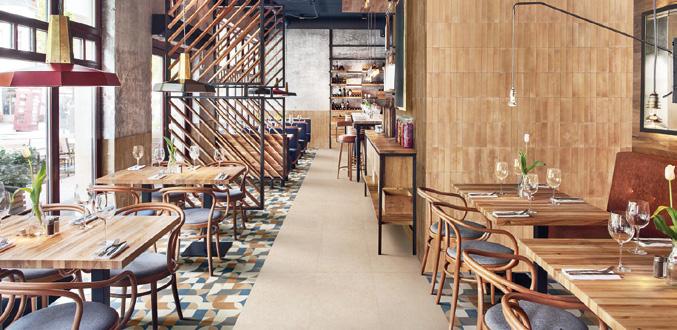

The collection’s range of neutral and trendy colors – White, Ivory, Blue, Anthracite and Pottery – is inspired by the Marazzi Concrete Look, in which soft shades and irregular graphics recall the expressive power of concrete. Five contemporary shades ideal for numerous mix&matches with the floral, botanical and geometric decorative patterns of the collection – Hawaii, Zone, Florida and Exotic – to create combinations with the most diverse results and versatile installation solutions both on walls and floors. The proposals are declined in two formats – 60x120 cm and 30x120 cm – and in the thickness of 8.5 mm.
Poster also boasts a guarantee of permanent antimicrobial protection. The Puro Marazzi Antibacterial technology actively and constantly eliminates bacteria and other contaminating microorganisms in any light condition, hygienic and long-lasting, it does not contain or release harmful substances and eliminates stains, odors and other wear factors.
“Everyday” is Pastorelli’s new collection of oak-effect ceramic coverings.
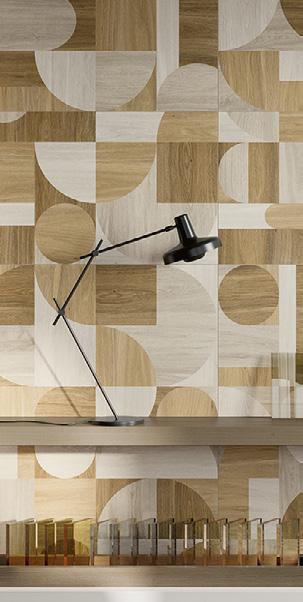


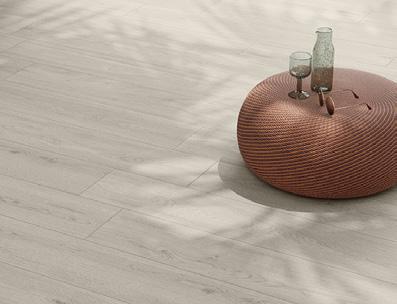

Designed for both floor and wall tiling, the new collection comes in sizes 26.55 x180, 20x120and 10x60, all of which give simultaneous expression to both the traditional and modern spirit of a material that is suited to a wide range of uses.
The smallest size, 10x60, offers the maximum versatility in terms of styling and installation, and can be used to put a creative new angle on tradition through a timelessly sophisticated herringbone pattern and the creation of highly original “carpets”. These evocative formats are complemented by Energize, a decora-
tive field-tile featuring incisions 2mm wide by 2mm deep, for filling with coloured grout to enhance the appearance of the joints and bring movement and dynamism to the surface.
Connect, meanwhile, is a wallpaper-effect tile with a distinctly ’70s feel, which combines all four wood colours. Reproduced with 12 different faces for random installation, the Connect accent in size 60x120 can be used on both floors and walls to create dramatically evocative effects.
Available in four colours – Honey, Brown and Taupe for warmth and White for neutrality – the Everyday collection is available in a thickness of 8.5 mm for indoor use and 20mm for outdoor use, in size 40x120.
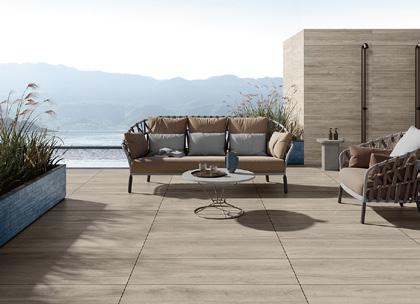
NG Kütahya Seramik brings a completely different dimension to spaces by using DDG (Digital Decoration&Glazing) technology in its industry 4.0 factory. NG Kütahya Seramik, which is the first and only company in Turkey and one of the few companies in the world that uses the relevant technology, adds an extraordinary depth to modern and classical marble textures with a 3D look and can reflect effects that cannot be achieved with traditional methods, thanks to this technology. Ares, Damasen, Lord, Luserna, Darka, Darka, Travertine, Artos, Beton, Liberty, Nuvola, Atrium, Aston and Moonstone series of the special collection offered in both matt and glossy outlook introduce today’s architectural world with sophisticated and rich surface options.
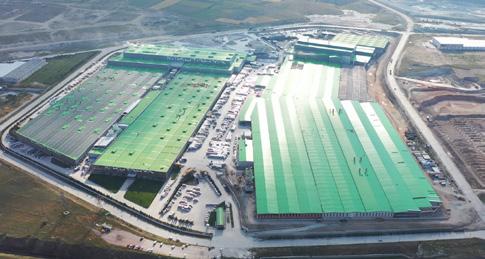
The STARDUST EFFECT collection, dominated by gallant color tones, appeals to users who want to bring different identities to their living spaces with its crystal effect, different color transitions and soft surface texture. NG Kütahya Seramik, also with its Soft collection creates a brand new philosophy of life. The main products of the modern marble design, Tosca and Crown, travertine looking Ravel, Loren and Carrara reflecting the serenity of white by appealing to the clear

feelings. The collection consisting of products creates a unique identity for living spaces with its soft surface texture.
The Metronorm series, which reflects the distinctive dimensional diversity of ceramics with its specific style, meets the needs of minimalist projects by providing the user with different flooring combinations.

Cutting and mitering large format tiles is a growing need which led Raimondi towards the development of the LAB wet saw range.

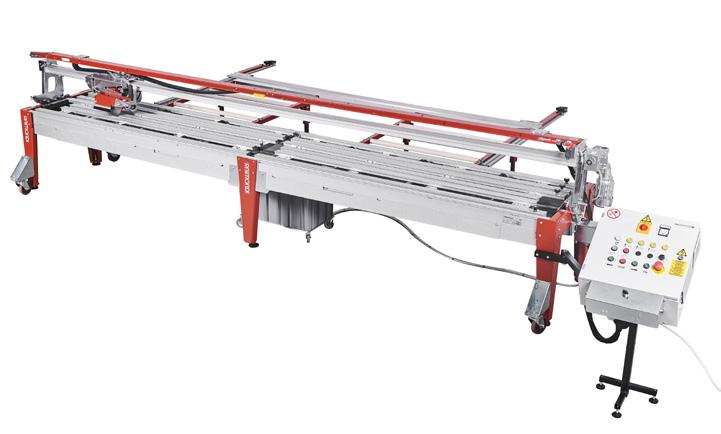

LAB400 is the top model. It performs cut and 45° miter-cut on slabs up to 400 cm long and 3 cm thick. The feed of the motor is automatic and managed by control board. Speed is adjustable so to choose the right one according to the hardness of the tile; this allows to achieve maximum quality of the cut. LAB400 comes with two side tables which allow to cut up to 161 cm width tiles. They are equipped with countersquare that allows (by means of digital devices) the precise and easy measurement of the width of the cut to be performed. Two more tables can be added to widen the cutting width up to 330 cm. LAB330 is a less sophisticated alternative to LAB400 which, however, provides very similar performances. In fact, LAB330 cuts (and miter-cut) tiles up to 330 cm long and 161 cm wide (expandable to 330 cm). The maximum depth of cut is 2 cm. Motor feed is manual via hand-wheel. Both LAB400 and LAB330 are excellent solutions for processing large format tiles; to choose from based on specific needs.
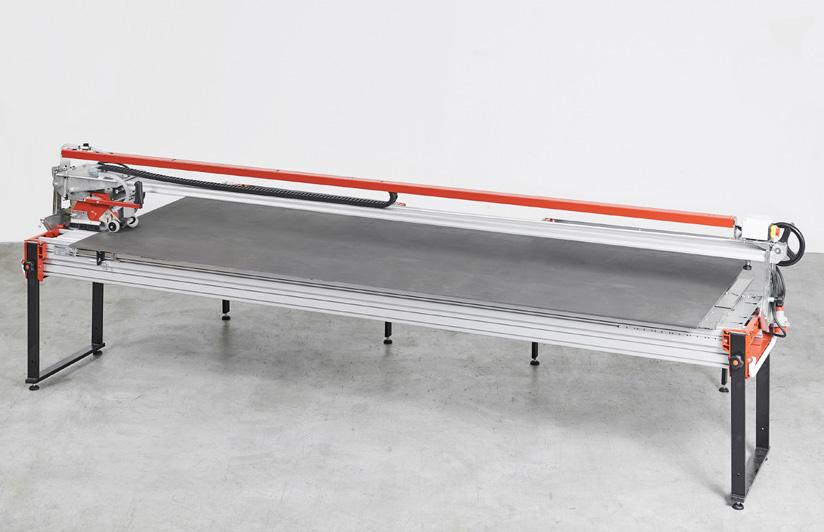
“Reflet”, a winner of the ADI Ceramics and Bathroom Design Award, is a collection of large-format porcelain panels specifically aimed at the architecture and luxury market.

Developed in collaboration with Andrea Boschetti (Founder of Metrogramma and Head of Design at The One Atelier), “Reflet” is a reflective material with a high degree of weather-resistance, which makes it ideal for outdoor use in façades, where it is a perfect medium for conveying endless narratives around the relationship between architecture, nature and places that combine the two.
Thanks to this new ceramic collection, the architectural use of reflectivity evolves from a narrative device into a purely structural one: deciding to design a form that reflects something means first developing projects capable of listening, talking and fostering dual relationships with nature and the local context, and actively addressing the “grammar” of landscapes, in line with the principle of blending architecture respectfully into its surroundings. It is available in two finishes – “Antique” with an antique mirror effect and “Sketch” with a matt effect and bright highlights – and in three colours: “Midi” based on the varying shades of Champagne, “Aurore” on copper and “Soirée” on silver.
The product was used for the exterior finishings of the façades in the urban project “Karl Lagerfeld Villas in Marbella”, by Andrea Boschetti for TOA, because of its innovative, premium finishes, which are the ideal accompaniment to a masterplan aimed at the luxury market. Its reflective qualities and durability fuse with the design concept, to help showcase the features of the surrounding environment.

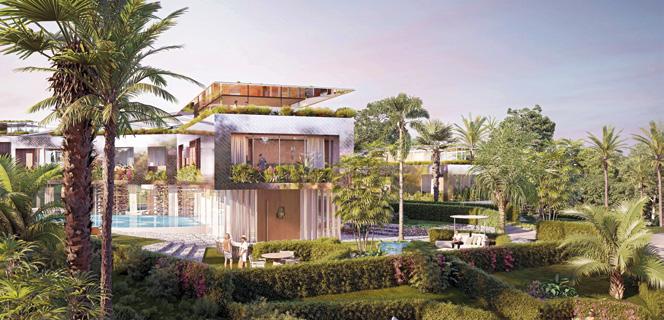
The specialist in installation tools and accessories for tiles, porcelain and natural stone, has a sales team with international coverage through operational offices in Brazil, USA, Europe and Latin America. Always looking for consumers needs and global trends in the segment, Cortag offers a specific line of solutions for large formats. Among these innovative possibilities is the Infinity tile cutter, which cuts porcelain tiles up to 3,40 m with the standard 3 guide kit and is suitable for use on tiles up to 8 mm thickness. It also has transport and handling systems for these pieces. Everything to ensure that the work is carried out safely and to produce a final result that exceeds the customer’s expectations.
Among the releases of the year there is the Professional Tile Cutter Mega Plus.
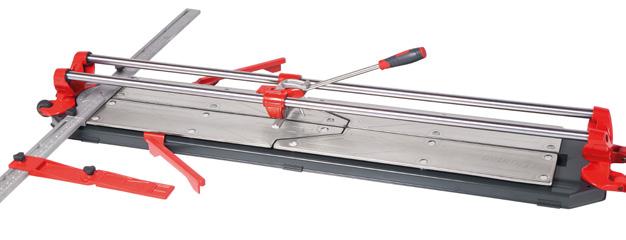
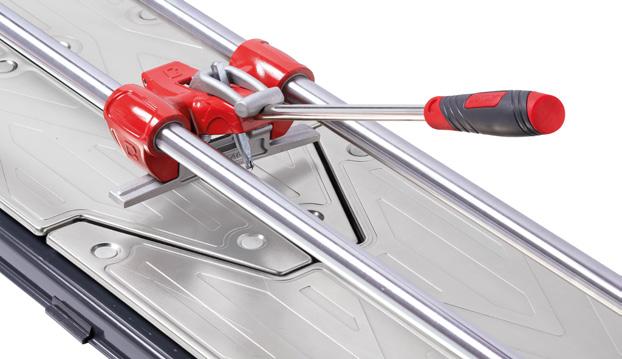
• To keep up with the trends of large formats, the Mega Plus Line has side rulers with cutting marks up to 630 mm, totalizing 1,23 meters. Backrest bar in injected aluminum, with positioning and stopping system for straight and diagonal cuts.
• A powerfull tile cutter: light cutting with a 1 ton separating power.
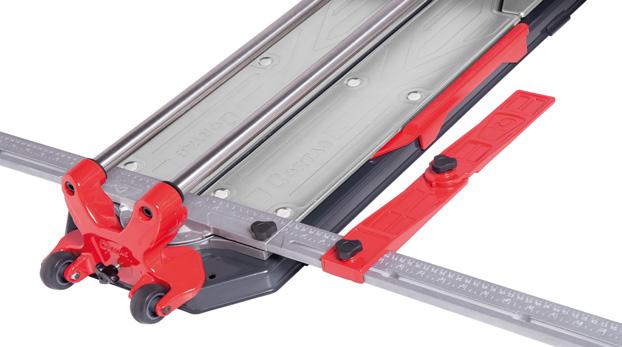

• Angle cuts from 0º to 45º: customized cuts according to angle necessities
• Injected aluminum angle regulator: greater stability for cutting large-format tiles
• Lateral support with protective paint: tile’s protection while handling the equipment.
• Rubberized handle and wheels: ergonomics and convenience to move the equipment during the work.
Cortag produces much more than tile cutters. The company offers complete leveling systems with different sizes spacers, wedges, floor joint spacers, horseshoes spacers and double spacers. Diamond cutting blades for cutting, grinding and polishing. Cortag also develops trowels of various materials and sizes to adapt to the consumer’s needs at any given moment.
With MyDesign by Schlüter-Systems, the Iserlohn-based company is now offering a programme with which numerous Schlüter products can be colour-coated – and in no less than 190 shades of the RAL CLASSIC colour chart.
Schlüter customers already offered its customers a wide range of colour coatings for aluminium profiles and the convenient SHELFwall storing shelves - including the nuanced colour choices of the Schlüter-TRENDLINE programme.


In many cases, this enables the customers to choose products with an optimal colour match for the respective tile covering.

To realise colour preferences outside of these options, the market leader has developed the MyDesign programme. This way, almost every project can be individually implemented, be it the corporate design guidelines of a company, a matching accompaniment of coloured object ceramics or unusual colour preferences of a building owner. With 190 colour options the creative possibilities are virtually unlimited. The shadesoftheRALCLASSICcolourchart are available for the Schlüter-QUADEC, -RONDEC, -JOLLY and -FINEC finishing profiles. I n a ddition, t he skirting profile DESIGNBASE-SL can also be coated in a colour of choice, as can the practical Schlüter-SHELF wall storage shelves.
From a bathroom to a coffee point in the office to a hotel lobby: MyDesign allows for a wide variety of rooms to be designed with a uniform and individual colour concept. The extensive custom colour programme can also be used for outdoor areas.
Various BARA profiles for securely finishing the edges of balconies and terraces are available with individual coatings.

RAK Ceramics is continuously pushing the boundaries of product and process innovation, by intrducing new state-of-the-art and sustainable surface collections.



The porcelain ceramic collections are created using new, modern technological processes, with impactful visual and sensory characteristics. Among the latest innovations created by RAK Ceramics R&D, there are ORBIT 3Rs and Absolute Matt.
ORBIT 3Rs is an excellent choice for architects and interior designers due to its high technical performance, which is due to the raw materials that make it resistant to weather and the effects of time. The durable and compact structure of these products lends an exclusive design and a natural effect to the tiles, making them ideal for new construction trends and tailoring private homes for both outdoor and indoor environments. The Orbit 3Rs were chosen due to their low maintenance requirements and adaptability. RAK Ceramics is dedicated to preserving the environment by introducing eco-friendly products. This material is made using solid ceramic waste from other manufacturing steps. By using up to 95% recycled materials in the manufacturing process, Orbit 3R contributes to reduction, reuse, and recycling. Orbit 3Rs is available in the new collection Creative Concrete, and many more.
Absolute Matt focuses on tiles with a no-reflection surface and a completely non-glossy finish. An extraordinary technological achievement that takes the concept of matt to new heights by enabling tiles to achieve an extra-matt surface. Absolute Matt enhances the tile’s natural texture and durability, meeting the aesthetic and functional requirements of any design project. Absolute Matt is available in the new collections Metamorfosi, Milano Stone, and many more.
The first company to earn greenguard certification guarantees sustainable production and compliance with ethical and environmental standards
LATICRETE®, a US group with a global presence, is rapidly expanding on the European market.
Thanks to an increasingly innovation-driven approach, LATICRETE remains fully committed to its R&D work, aimed at developing installation solutions and systems for all types of specific needs, which are known and established on the American market, and have been establishing themselves for some years now in the European construction industry.
LATICRETE Europe’s headquarters is in Castelnuovo Rangone (in the Italian province of
Modena), in the heart of the Sassuolo ceramic cluster. This is the source of all the main innovations for the continental market, which are increasingly focused on a combination of performance and sustainability: choosing LATICRETE means guaranteed performance and therefore increased productivity.
The company’s important sustainability goals include reducing waste and saving energy by offering high-performance, long-lasting products and using the latest low-emission, environmentally friendly technologies
LATICRETE solutions meet stringent quality standards that guarantee long-lasting, first-class results, thereby supporting the needs of bio-construction.
LATICRETE has always taken care of the environmental impact of its production processes, and has chosen to harmonise its production in an innovative, sustainable, safe and transparent way. This has earned the company important certifications for its products:
• GREENGUARD: As the first manufacturer of tile and stone installation systems to earn GREENGUARD Environ-

mental Institute certification, LATICRETE offers products that are independently tested and certified to the highest environmental standards, thus offering low VOC emissions for commercial and residential buildings alike.

GREENGUARD and GEV EMICODE certifications testify to the fact that the specified LATICRETE systems meet the appropriate indoor air quality standards for volatile organic compounds (VOCs), thus ensuring safe and healthy indoor air quality.


• LEED certification of sustainable energy efficiency for better quality of life in offices everywhere.
LATICRETE provides specific environmental product declarations that transparently document the impact of its products on the environment and on energy efficiency throughout their life cycle. Furthermore, hundreds of work places worldwide have earned LEED credits by using LATICRETE systems.
experimentation and passion. It does this on the basis of Environmental, Social and Governance (ESG) criteria that underpin sustainability and corporate responsibility, including working conditions and the fair treatment of people (Social) and the management of waste and emissions (Environmental).
The Rothberg family, which founded LATICRETE 65 years ago and has been running it ever since, has always believed in the effectiveness of adhering to ethical policy, both internally and externally, prioritising the human aspect of interpersonal relationships and promoting a vision of growth through collaboration,

Equally important is the company’s focus on user-friendly products: by offering solutions that combine advanced performance and ease of use, LATICRETE is committed to promoting sustainability, focusing on the health and safety of the workforce, improving social impact and reducing the adverse environmental and health impacts of building.
info@laticreteeurope.com https://eu.laticrete.com/it-it




Conveniently located on the street level of the Dubai International Financial Center (DIFC), Orijins, a sleek new coffee shop designed by Dubai-based interior design firm VSHD, draws its inspiration from the
The space exudes a rich amalgamation of contrasts: the large blocks of uneven stones, the slender lightweight metal furnishings, the subtle curvaceous elements, and the muted colors. Of note is the coffee bar made of solid blocks of different kinds of marble. Its beautifully curved shape - an unusual structure for your typical coffee bar - adds itself a dreamy and raw form to the light and airy space.
beautiful imperfections found in nature. Simplistic in form, and rich in texture and materials, the design of the café showcases the beauty that can be found in a sparsely decorated space of muted plaster and opaque
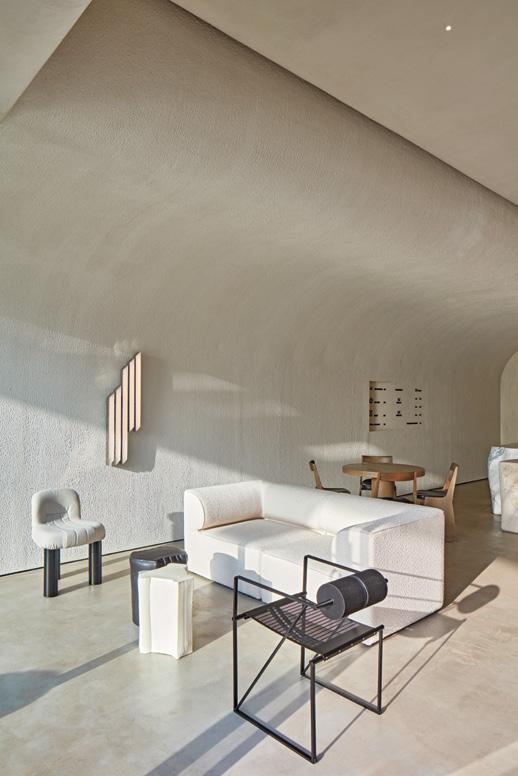

VSHD put great focus into incorporating a mix of textures and materials, all with minimal color contrast and definition. Of note are the textiles - fur, boucle, and heavy weaves - used to complement the raw natural concept and sculptural quality of the design and resulting space.
The main inspiration for the café was derived from the

creamy hues, which borrow their subdued colors from natural elements such as sand, shells, stone, and wood. In the absence of a rich use of décor, visitors are instead


prompted by the forms that bring the space to life, such as the curved volumes in the ceiling, which provide a feeling of calm and grounding.
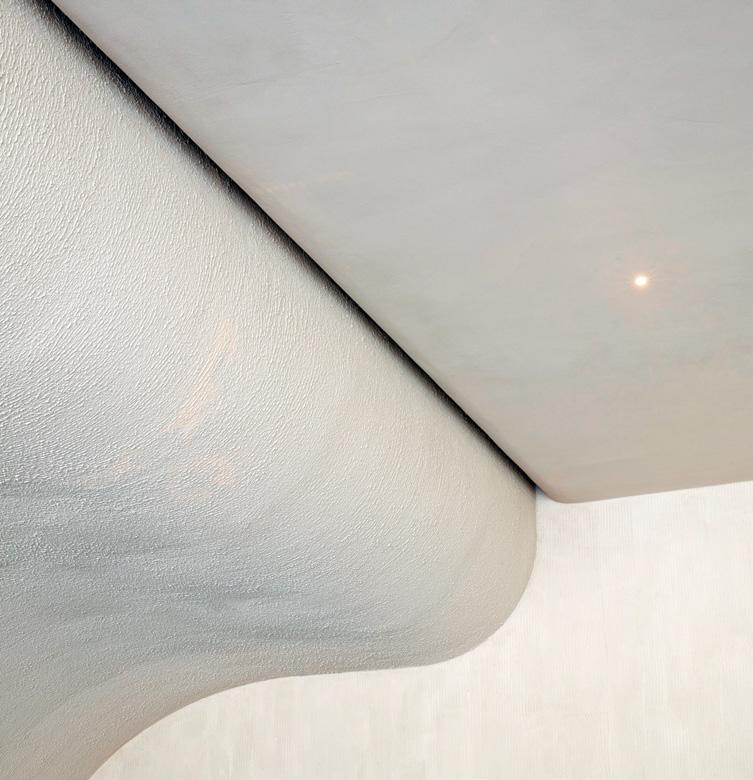
natural world, and from a collection of stones picked up from the shores of the red sea. Nature takes the lead here, but it does so innovatively. Just as the natural light gently beams through the space, leaving an array of shadows on the plastered earthy walls, the close observer will also notice the almost enigmatic influence of technology. A very slim LED strip, located along the length of the space, showcases a gen-
tle arch in the ceiling. It is a small spotlight that illuminates the bar area and a bespoke wall light designed by VSHD, and is made in brushed aluminum that ever so subtly decorates the sparse space.
Chiara Bruzzichelli c.bruzzichelli@tiledizioni.it
In many ways, Orijins offers the sanctitude of an ancient chapel. The minimalistic interiors relay a rare beauty found through the magic of opaque hues and rich natural materials. Such a sparsely decorat-
ed space is also representative of the vision of VSHD, and belief in the beauty of imperfection, and the humility and integrity that comes from living in tune with imperfect nature. Orijins represents the design firm’s interpretation of what it means to be calm, to sit still, and to observe the beauty that can be found even in our flawed, everyday reality.



The silver lining of the pandemic is that it once again brought us closer to nature and allowed us to fully appreciate it. Nature is divine: VSHD designs are all about going back to the origins of things, and creating an environment that is as close to nature as possible. It’s the feeling of calm and serenity one gets when sitting on a rock by the sea or sand in the desert.

Relentless sketching of abstract shapes and volumes fosters a feel of rocks shaped by the force of nature. Taking a very innovative approach to the layout of the coffee bar, the 7 marble blocks were sketched by hand, converted to 3-D models, and were fed into a CNC machine to produce the abstract forms, creating a sanctuary mood with muted textures, organic


shapes, and earthy hues. The shell of the space was the canvas for those abstract volumes, with its curved walls with grains and textures, bringing the whole feel back to nature. This overall mood is simply calm, and it is what keeps the coffee flowing and the lines of coffee lovers outside of the coffee bar queuing to be seated. ✕





Nestling among maples and fir trees in Canada’s Quebec region, Atelier C is the studio-home of a couple of creatives – she is a writer and he is a
The starting point for the development of the architecture was the owners’ desire to have a single-pitch roof that would define a simple, linear volume, ideally forming part of the natural setting, within which there would be no clear partitions.
photographer and musician – which combines traditional domestic functions with a suite of perfectly integrated work spaces.
Drawn up by Nicholas Francoeur, the design meets this requirement and associates the diagonal, geometric pattern of the roof with the idea of an unconventional ‘passive house’ featuring a unique range of details.

“From the ceilings at various heights to the open-space areas for music and writing, which were designed almost as transit zones rather than closed rooms,” explains the designer, “from the constant contrasts of colour and material, to the bathroom with its theatri-

cal lights and cave-like atmosphere, like a cavern of well-being: everything in this house is designed to stimulate creativity, while also giving its inhabitants the impression they are simultaneously alone and in company. There is a unique atmosphere.”
Chiara Bruzzichelli c.bruzzichelli@tiledizioni.it


Atelier C has an L-shaped floor-plan and a clean, simple building envelope: the ventilated roof is clad with trapezoidal sheet metal, while the underlying part is made of bleached poplar. The façades are made from carbonised cedar-wood boards which enclose the volume, punctuated by narrow, glazed, vertical openings on the north front that create the effect of a rig-
orously contemporary colonnade; while on the southern front, the windows are wider, to let plenty of natural light into the work spaces. The interior is more fluidly structured and is light and bright, with the sole exception of the kitchen area, which reprises the colour of the envelope and features a Lapitec sintered stone countertop, made from a silica-free blend of 100% natural minerals, with no resins, inks or petroleum derivatives.

The kitchen is the heart of the house: it is a large room with base units and col-umns on three sides, and an island in the middle for food preparation, dining and socialising. The front panels are made of dark lacquered wood, while the countertop in the different areas is made entirely of 12mm-thick Lapitec, in Nero Antracite with a Vesuvio finish. The sintered stone in this Hauteur d’Homme kitchen was machined and honed

to accommodate the sink, and thanks to its throughbody composition, the full thickness of the edge is of the same colour as the surface, which is non-porous and free from digital printing. Lapitec is also immune to deterioration and resistant to chemicals, impacts, scratches and UV rays. Furthermore, it does not absorb water or liquids or re-tain dirt, mould or bacteria, and is endorsed by NSF/ANSI Std. 51 FOOD ZONE certification, which guarantees effectiveness in kitchen environments. ✕

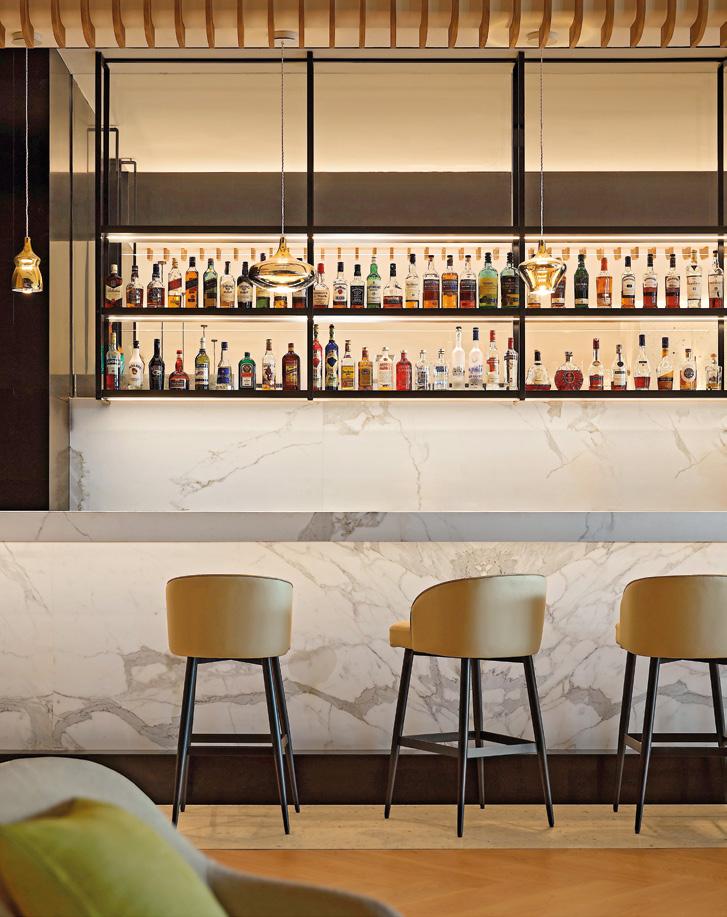

The Westin Pazhou Hotel (Guangzhou) was jointly built by China Foreign Trade Center (Group) and Starwood Hotels and Resorts International Group

It is located in the center of the world-renowned Guangzhou International Convention & Exhibition Center, with excellent city skyline or Pearl River views.
the perfect combination of tradition and modernity. The outdoor sunroom, a large transparent space fully enclosed in glass, is the highlight of the renovation design. The space can accommodate up to 107 people for simultaneous dining.
From the hotel, all exhibition halls of the Canton Fair can be reached through a sky corridor.
By day, guests can enjoy the mental and physical benefits of dining within the embrace of warm sunshine. By night, guests can indulge in an evening of delicious food with wine, with sunset and starry sky external views, ideal for a romantic experience.

“Canton Bazaar”, the name of the all-day garden restaurant, references the abundant flavors of a Cantonese food market. The designer adhered to the design
Chiara Bruzzichelli c.bruzzichelli@tiledizioni.it

concept of “An oasis in the city, a garden full of vitality”, and incorporated elements such as the theme of the Canton Fair, the concept of the One Belt One Road, the historical background of the Maritime Silk Road, and the authentic Lingnan culture of Guangdong.
Additionally, the space was redesigned in the form of “The Market”, a division of 9 specific DNAs: “The Baker’s Corner”, “The Juicery”, “Farm To Table”, “The Fisherman’s Table”, “Open Kitchen”, “Communal
Table”, “Green Sanctuary”, “Partition Wall”, and “Locavore Corner”, collectively contributing to a fashionable, youthful, and diversified gourmet oasis reflective of Guangdong characteristics.


The MOK design team devoted a great deal of time to the brand characteristics of the two groups, as well as to the historical culture of Guangdong. Elements incorporated into the design include some geographic characteristics of Guangdong, which

serves as a stop on the Maritime Silk Road. Other elements reflect the main products exported by the Maritime Silk Road - porcelain, bronze, and Cantonese embroidery - as well as the development history of the Canton Fair.


The mosaic mural was originally created by contemporary artist, Ms. Zhang Haiyan, who later drew the
manuscript of this mosic mural with colored lead for this program along with designer, Li Yanfang. The manuscript was then sent to an Italian mosaic factory to be used for mural making. The main elements of the screen are: the Zhenhai Tower, bombax ceiba, harbour, Guangzhou Tower, merchant ships, seagulls, and cloud patterns, which vividly reproduce the prosperity scene of “All kinds of goods in the world are imported into China from overseas. Tens of thousands of wine shop owners take
care of each other in business”. Servings as the background of the lobby dining area, it subtly contributes to the creation of the atmosphere.

As the designer said: I hope people feel relaxed when they enter this space, instead of rushing to take pictures.
At the junction of indoor and outdoor, in addition to a tea bar in the corner where you can wait or rest, a bigger surprise awaits - the outdoor garden.
The scenery and objects of the garden drive all of the senses. A piece of greenfield was “transplanted” to the front hall, where you can breathe the fresh air, hear the crisp birdsong, see the brilliant colors, and touch the textured materials to heighten your mood.
The 6-meter-high transparent space is bright and wide. Plenty of daylight contributes to an impressive, dreamy scene. There is also a tea bar where you can drink. The hotel’s unique location, and the transparent, bright, and natural restaurant outdoor sunroom, make it a primary choice for many wedding banquets and conferences.

The style of the restaurant is modern and elegant, combined with the form of “The Market”. It has an enclosed, island-style baking “market” and “The Juicery” area, as well as an open kitchen featuring a variety of Cantonese flavors and Asian cuisines.
The high-class, yet simple style of the restaurant includes elegant, light-colored marble textures, grille elements, and warm, light brown tones. The interior can accommodate a total of 219 people. Through an in-depth analysis of the flow of people and business models, the design team aimed to create both a completely independent private space, and a largescale open area, combining in an independent and integrated market format to meet the various needs of its customers, as well as the needs of its multi-period operations.
Marble and grille elements are used in “The Juicery” area, which is visually connected to the Baker’s Corner. The simple golden chandeliers are like tangible musical notes, jumping into the cups of guests. The diversi-

-
The

The precise
ty of the space allows for communicative group gatherings, or tranquil moments alone.
The design of this space has both function and aesthetics, and it also generates economic benefits. In detail, MOK flexibly uses glass screens, grilles, and greenery to separate the open dining area, the private room, and the VIP room in the lobby.


The layout of the open dining area and the VIP room is semi-open and semi-private, and light can flow freely in both spaces. The designers constructed the boundary of the space poetically. On the wall of the VIP room, the designers have ingeniously arranged a world map with a black metal frame, echoing the frame color of the glass screen, the material, and shape of the indoor chandelier, and the black and white photos on the wall. Their appearance differs when viewed from different angles. At the entrance, the designers used green plants to decorate the wall, and also dotted the lobby with green plants. The large-leaf green plants not only ensure the privacy of the space, but also ensure the transparency of light and air circulation. ✕

“We don’t want to create fast fashion designs that will soon become obsolete, but rather use the most simple decoration and design techniques to meet the function, consider the economic bene
fits, and attach importance to the communication between people.
reconstruction design of the all-day dining restaurant in the Westin Pazhou Hotel not only conforms to the aesthetics, but also reflects the local culture and history.
and poetic design and application of well-connected materials with art and design, which inspire guests and enhance their dining experience.”MOK Design team


The interdependence between the building’s structure and the architectural project enabled great creative freedom, culminating in the most prominent element: a second skin that “wears” the building like a garment, giving it unique characteristics. The material used was aluminum, painted in an earthy reddish sepia tone that alludes to the abundance in Minas Gerais of raw ore.

In order to obtain lightness and transparency, the aluminum sheets received perforations in different sizes, and were made in an asymmetrical, yet harmonic way. That process makes it possible to see through them from the inside out, where city views are exposed through the skin.
However, from the outside looking in, it isn’t possible to see the interior, guaranteeing privacy to the resident. This element also made it possible to explore a rich range of effects, from hiding smaller, functional windows, to tearing the skin to expose the large spans. Conceived as generous openings, these windows allow the city to become an extension of the house, with
lot, with a width of 12.7 meters. The challenge of its volumetric mathematics, to respect distances, was one

of the factors that influenced non-obvious decisions resulting in architecture created with its own identity.
abundant light and ventilation. The concrete frames of the openings contrast with the predominant oxidized color.
Chiara Bruzzichelli c.bruzzichelli@tiledizioni.it
The skin covering the building also provides thermal comfort to the units. Away from the masonry, it provides shading of the fences and good ventilation through a mattress of renewable air. From that perspective, sustainability guided a large part of the project’s choices.

Due to the reduced dimensions of the land, and minimal rooftop space for installing equipment or photovoltaic panels, it was necessary to find a solution that would avoid the entry of heat, to the detriment of an air conditioning project.
The building’s pyramidal shape, which is the result of staggering, also made it possible to allocate technical areas on the external face of the masonry, as well as on the internal face of the skin, ensuring a clean and unadorned plastic.
Another highlight of the project concerns the challenge of placing the pyramid on the ground, touching the land lightly at a single point.
Under the influence of Brazilian architect, Oscar Nie-




meyer a “V”-shaped pillar was created, which is widely used in his works.

Finally, to ensure flatness on the facades, the sheets were bent on all four sides, thus increasing their rigidity. Although the sheets were randomly perforated, the joints were aligned and the volume was harmonious, several studies were carried out until the final fixing model produced an alignment of the slabs and the midpoint of each floor.
The study ensured optimization in the secondary structure for fixing the plates: there are only three horizontal profiles per floor, and the upper and lower profiles were also combined to fix the plates of the adjacent floors.


The final plastic is the result of a marriage between covering sheets, frames, and structure. There are three elements that alternate on the facades with greater or lesser relevance of the skin, ensuring a clean and unadorned plastic. ✕

This private residence just outside Trento (Italy) is designed to offer maximum enjoyment of its mountainous surroundings and stands out for its spacious feel and minimalist interior design.
The undisputed star of every room is the natural walnut flooring, which was selected directly by the client for its powerful decorative impact.
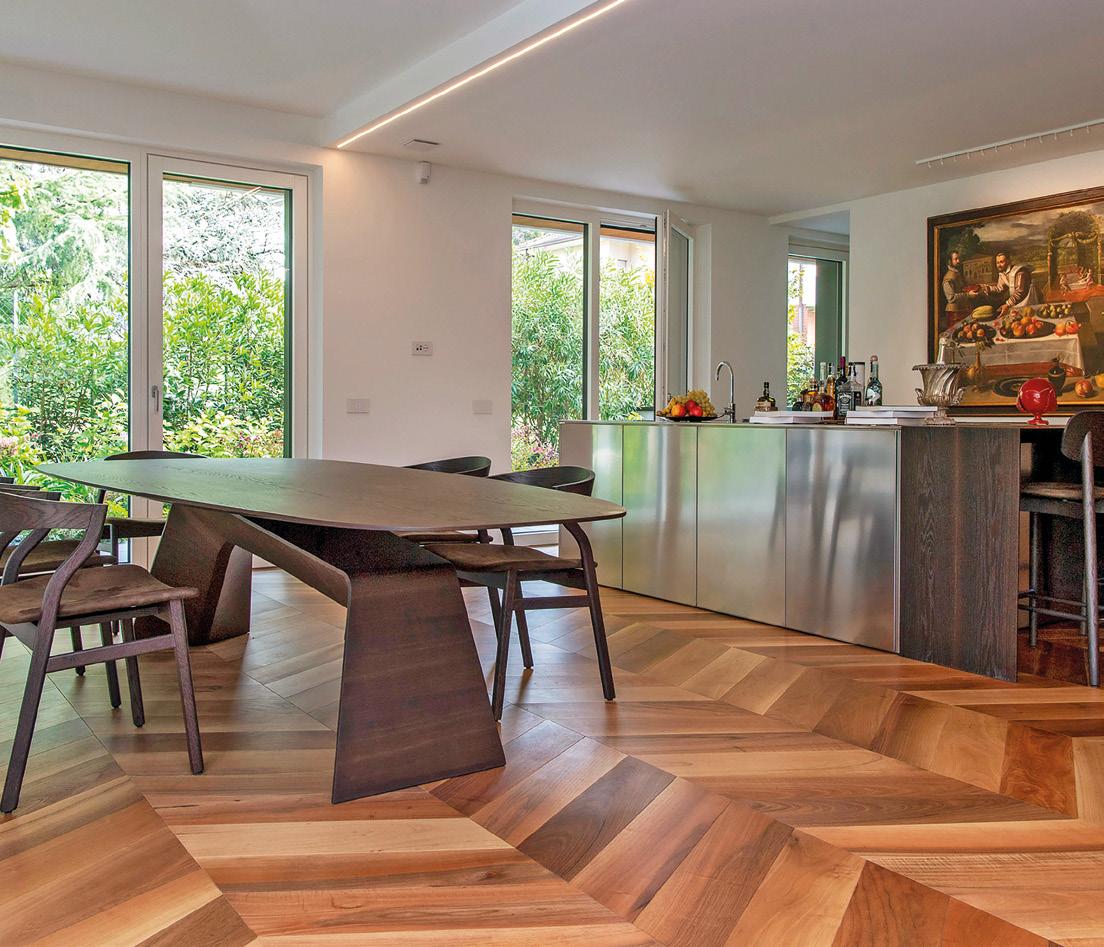
Produced by Woodco, the flooring is finished with brushed extra-matt varnish, and is the clear centre-piece around which the whole interior design revolves, thanks to its strongly accentuated nuances, which graduate from caramelised tones to darker, more intense hues.
Spread over four storeys, one of
which is partially below ground, with a total area of about 400 square metres, the house is designed in such a way that each floor has its own specific function: the basement hosts a gym and sauna, the ground floor is for hospitality and conviviality, the first floor is the sleeping area and the top floor is a place of intimate immersion in the

landscape: it has a large terrace with hydromassage tub, from which you can enjoy the unrivalled views. In the living area, the natural walnut parquet flooring gives the rooms rhythm and vitality with its spectacular Hungarian herringbone installation pattern.

The imposing size of the herringbone, which is as wide as a table (180mm), was chosen directly by the client.
The manufacturer therefore developed a bespoke product, tailored to the specific needs of this project.

The kitchen is dominated by a large stainless-steel island and a table with clean-cut lines, whose modern feel strikes a powerful con-
trast with a large 16th century painting, which reprises the warm, welcoming tones of the walnut parquet.
The result is an environment that feels semi-professional but welcoming at the same time.
For the bathrooms, staircase and sleeping area, which includes seven bedrooms, the client opted for traditional walnut floorboards.
The exceptionally large size of these floorboards (1400/2200 x 180x14 mm) showcases the grain patterns of the wood to perfection, while at the same time enhancing the airy feel of the rooms.
For the top-floor terrace, the client chose “Externo”, an outdoor cov-
ering material for creating wood-effect surfaces of unrivalled performance
Made from an eco-material comprising high-density recycled polythene and wood flour, the “Externo” floorboards are resistant to UV radiation, high and low temperatures, weathering, chlorine, insects and fungus.
To dial the performance up to maximum, the client specified the “Extrashield” version, in which each individual floorboard is encapsulated in a shield-coating that increases the overall ruggedness of the floor, making it completely maintenance-free.

The new “Secret Gardens” wallpaper collection originates from Devon&Devon’s collaboration with the Marcel Wanders interior design studio, and aims to change the way we look at living spaces.


Each of the four motifs that make up the collection transform interior walls into worlds of imagery designed to encourage us to explore, while arousing our curiosity, enchanting our senses or making us smile.
The individual modules of all the wallpapers in this collection can be hung side-by-side, either horizontally or vertically, in freely composed patterns. Prices from €145 per sq.m.

Designed as a deep-dive into the creative universe of Marcel Wanders studio, the “Garden of Dreams” wallpaper envelops interior walls in a surreal pattern.

Deriving from an unexpected fusion of maps of Florence and Amsterdam, the graphic design of Devon&Devon’s “Urban” wallpaper depicts a city that doesn’t exist and populates it with a mixture of landmarks, giving rise to a stylised, urbanised garden.
The ideal complement to spaces designed for comfort and well-being, “Zen” wallpaper is a gentle invitation to regenerate through slow contemplation.
Paying tribute to the most classic interior design motif, “Blossom” wallpaper puts an entirely fresh slant on traditional floral designs.
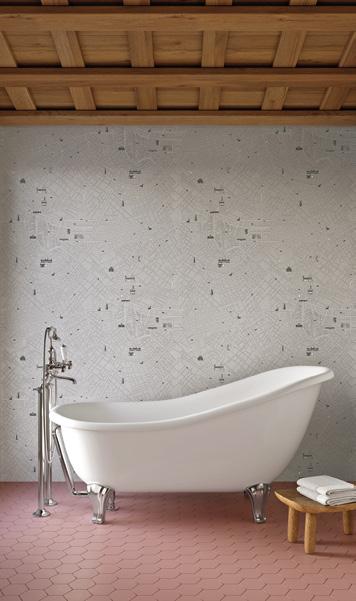

A Latin term, an ancient name to define a need for aesthetic spirituality that is highly topical in modern times. “Factum” is this and much more.
The direct influence of a master like Carlo Scarpa, this collection of wooden floors designed by Dante Oscar Benini and Luca Gonzo for the iconic Listone Giordano brand, reflects the deep-rooted mental percussion of its author. A surprising and unprecedented floor, the deco essence of a Versailles of the new millennium with a sublime rhythm and capable of metamorphosing in every sense. Factum is made up of three elements that make up the quadrotta, each of which can be interpreted in different colour variations or even in monochromatic versions, as in the square element, which can rotate freely and where the insert also aspires to become a different material. And, in turn, the squares can be placed side by side to create surface patterns with infinite compositions and rhythms that extend to become rugs or paintings that are always different - elegant and never banal - with a strong visual impact. With Factum, the floor rises up to the wall and thus also becomes a boiserie, completing an ideal circuit that turns the home into a safe haven of design. A collaboration in which Listone Giordano was deeply involved, contributing decisively to the research and prototyping process.


Using the medium of mosaic, SICIS has produced lifesize replications of some of the most famous drawings by the Russian painter and set designer Léon Bakst, namely the ones he created for the costumes of “Cléopâtre”, “Narcisse”, “Carnaval” and “La Péri”. With incredible professionalism, combining ancient craft techniques with new artistic languages, SICIS’s master mosaicists have succeeded in replicating the magnificent effects of the drawings. An array of gloss, matt, iridescent and metallic vitreous materials reinterpret the opulent garments in silk, organza, brocade and georgette, and the awe-inspiring jewels made of precious metals and stones, with which the artist loved to adorn the figures of dancers. The raw material fuses with the outstanding traditional craftsmanship of SICIS’s expert mosaicists and complements an array of innovative touches designed on a project-by-project basis.
SICIS was inspired to create this unique capsule collection by Bakst’s multi-faceted personality and his ability to interpret beauty in every medium, from art to fashion and design.

Cosmolite® is the hi-tech large-format panels project designed to blaze a new trail in terms of both style and substance: consisting entirely of pre-consumer recycled aggregates other than quartz, these surfaces offer unique aesthetic performance and perfect workability, as well as high standards of hygiene.
Available in five different collections and 20 colours, these panels are ideal for all large surfaces where strong environmental credentials are a priority (the carbon footprint for Cosmolite®, as measured in the Carbon Footprint statement, is almost 45% smaller than that of other comparable products).
The project is underpinned by three key factors: environmental performance (it helps create a circular economy in which recycled products are upcycled by introducing them into a new industrial process), industrial innovation (it is based on an exclusive formula) and design (the use of new materials gives rise to hypnotic, immersive aesthetics).
Recently presented at Sicam, “VENANTIS” is the latest Cosmolite®


2023 collection, whose name hints at the innovative feature of the range, namely the subtle vein pattern that runs through the entire thickness of the material, bringing stylistic continuity to the finished product (pictured). The range of six colours, from the softest white to bold black, via warm beige and innovative green, make Venantis the ideal choice for people looking for distinctive new products with a high degree of sustainable content and outstanding aesthetic quality for use in interior design elements such as kitchen countertops, worktops, cupboard doors and wall surfaces.



The “Rovere Termotrattati” wood flooring collection undergoes high-temperature heat treatment to remove moisture and improve physical characteristics, such as resistance to biological deterioration caused by fungi, mould and insects. Thanks to continuous research and experimentation, Original Parquet makes no use of chemicals or additives, and achieves high performance with nothing more heat, water and thermal treatment processes. The wood is dehydrated so as to free it from all substances subject to deterioration, thus making it more durable.


“Metal” is the new vinyl wallpaper with a metallic finish from Tecnografica, which, thanks to the silver film covering its entire surface, generates iridescent reflections when the light strikes it. This new finish showcases metallic colours such as gold, silver and copper, and makes bright, strong colours look particularly vivid.

In addition, the special fabric-like embossed effect makes this finish supremely elegant and suitable for all types of residential and commercial environment. This collection incorporates and enhances designs in different styles - inspired by nature, geometric patterns, dreamy landscapes and more - that become the central focus of every environment designed to shine and stand out. “Claire de Lune”, “Carillon”, “Japan-Forest” and “Kintsugi” are just some of the subjects created by Tecnografica’s artists and are also available in all the other finishes. The collection is presented in a beautifully designed, bound folder, known as the “Metal Wallpaper Folder” (see photo on the right) aimed at architects and designers. The folder includes a sample of “Paradiso 21”, one of the best-selling graphics, accompanied by a full technical data sheet.



RAIL SYSTEM
WITH RAIL SYSTEM , EVEN THE LAYING OF DECKING FLOORS IS EASIER AND FASTER.


NO MORE SCREWS, JUST ONE CLICK!
THE JOISTS CAN BE HOOKED TO THE HEADS OF THE SUPPORTS WITH A SIMPLE CLICK, WITHOUT THE USE OF SCREWS. THE INSTALLATION OF THE UNDERLAYING STRUCTURE HAS NEVER BEEN SO INNOVATIVE.


















